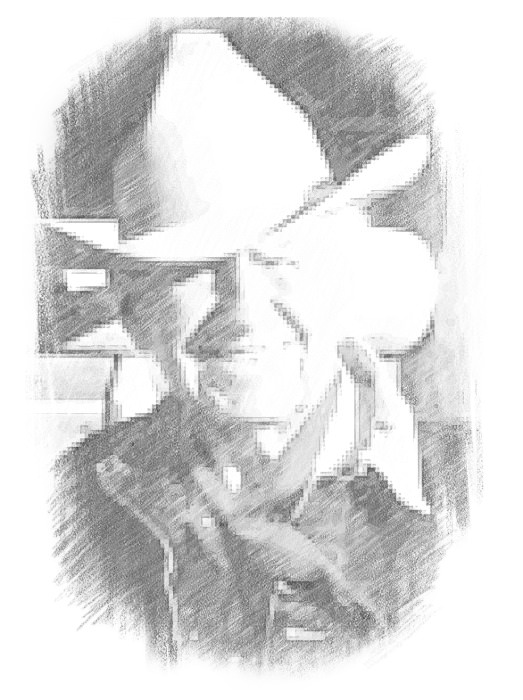
John Hampton, CA Founding Member
(1918-1999)
Well into his eighties, John Hampton, one of the founders of the Cowboy Artists of America, was still painting, drawing, and sculpting the many stories of the American West. Hampton was born in Brooklyn, New York in 1918, but made his way west at an early age. As a boy, he had shown an early aptitude for art and won a drawing contest sponsored by the New York World Telegram. Years later, while he was working as a cowboy in New Mexico, one of his cow bosses told him that he had the makings of a good cowboy, but an even better artist. Hampton combined those two pursuits for the rest of his life. One of his early jobs was working as an illustrator for newspaper comic strips, including Fred Harman’s Red Ryder and Little Beaver.
Hampton felt close to the Western life that he portrayed in his paintings and sculptures. In addition to working many years as a cowhand, he continued to keep his cowboy skills well-honed even after he turned to art full time. Hampton felt a deep affinity with the historic West. He once said, “I was born (1918) a lot closer to the start of the last century than the (beginning) of the next.” Hampton’s artwork is now in many museums, including the National Cowboy and Western Heritage Museum in Oklahoma City, Oklahoma; the Museum of Western Art in Kerrville, Texas; and the Montana Historical Society in Helena.
In 1965, Hampton got together with Joe Beeler, Charlie Dye, and George Phippen in Sedona, Arizona, to talk about the need to preserve and promote the art of the American West. As Hampton later recalled, “We didn’t feel the necessity to wait around and let the Eastern critics tell us what was worth painting in the West.” For thirty years, Hampton was an integral part of the development of the CAA. He remained one of the organization’s spiritual leaders from its inception until his death in 2000. During those years, the organization grew to become the leading light in the genre; a light that Hampton helped ignite with the help of three like-minded friends.
Source: Cowboy Artists of America
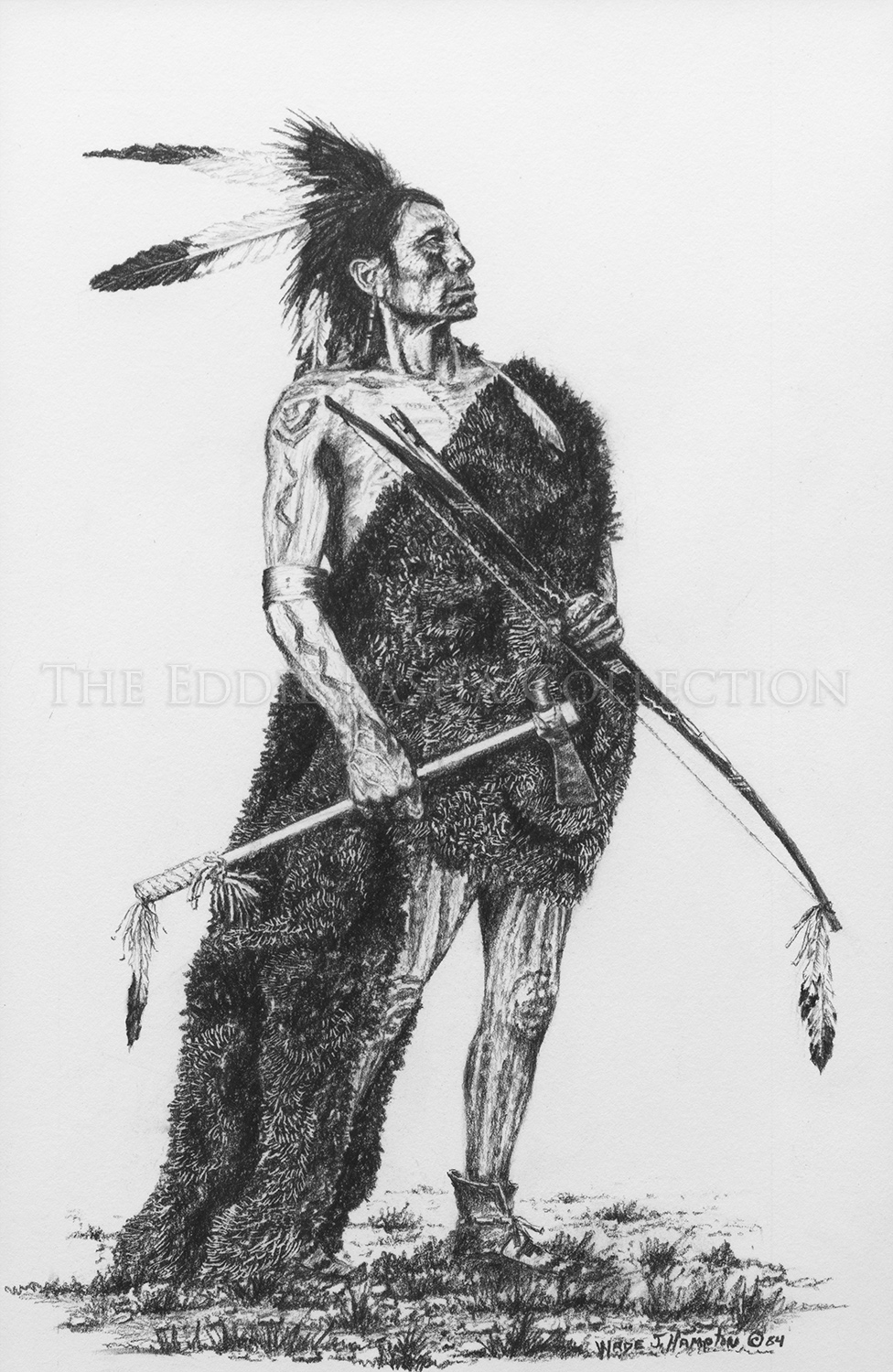
Unknown Title
Artist: John Hampton, CA Founding Member (1918-1999)
Description: Pencil (1984) | Image Size: 12”h x 8”w; Frame Size: 18”h x 14”wdrawing
An atypical pencil drawing by CA Founding Member, John Wade Hampton, signed Wade J. Hampton, depicts a full body portrait of a buffalo robe swaddled Indian looking off stoically to the distant right with a bow and arrow in his left hand and a long-handled hatchet in his right. This piece is more reminiscent stylistically to that of a Karl Bodmer drawing. Perhaps it is the reason he signed this and other similar pieces to it differently than he normally would sign his work.
Trail Drive
Artist: John Hampton, CA Founding Member (1918-1999)
Description: Pen & Ink (1996) | Image Size: 10”h x 13 ½”w; Framed Size: 19 1/2”h x 22 1/2”wdrawing
Honed over several years, Cowboy Artists of America Founding Member John Hampton was skilled as a draftsman who could draw almost any facet of cowboy life such as this drawing of a cowhand roping a wayward steer while at full gallop on his horse. With an economy of strokes, Hampton presents a realistic vignette of western action.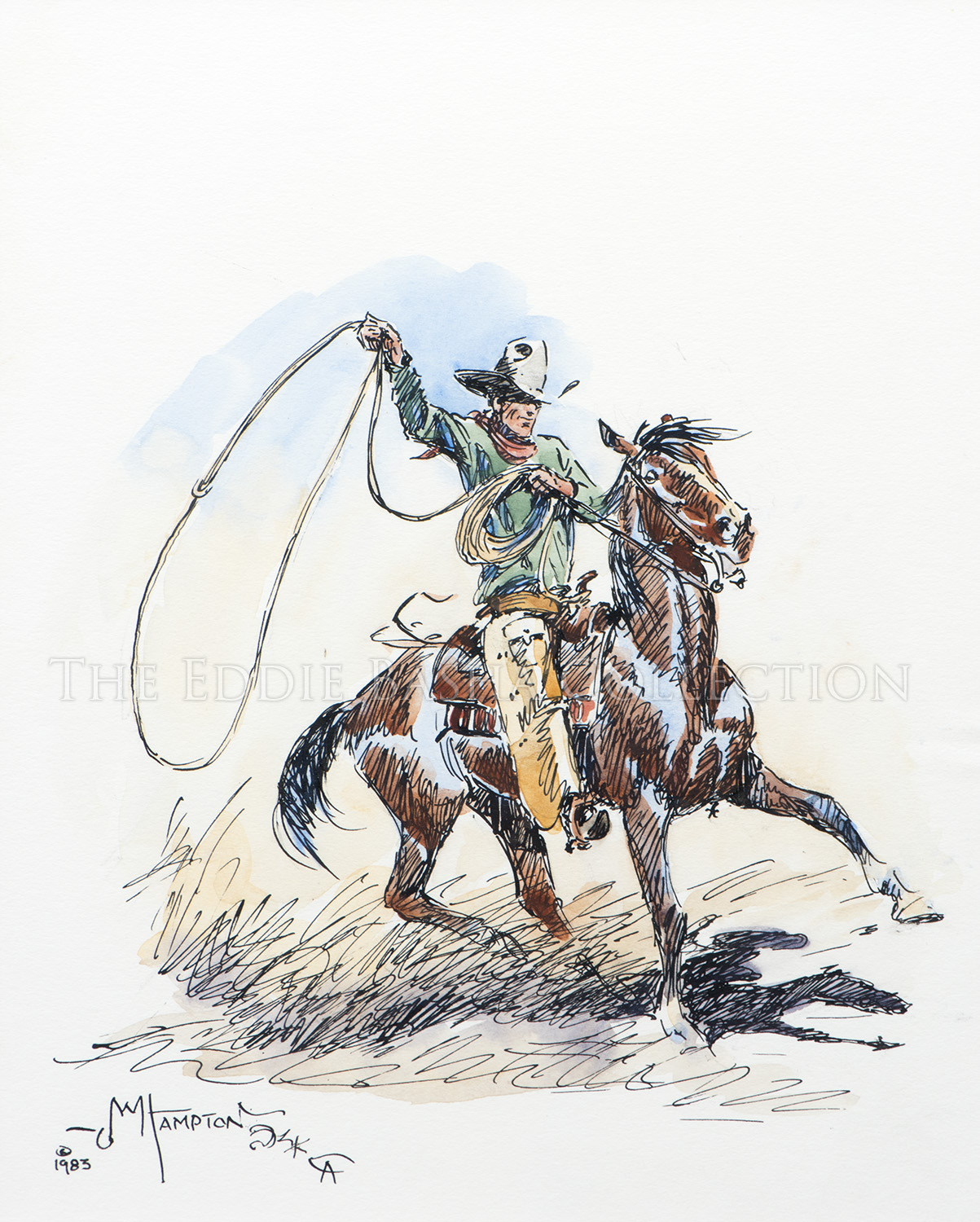
A Hungry Loop
Artist: John Hampton, CA Founding Member (1918-1999)
Description: Pen, Ink & Watercolor (1983) | Image Size: 10”h x 8”w; Framed Size: 18”h x 15 ½”wpainting
A cowboy’s hungry loop is intended for a cow, a colt or whatever he or she is focused on lassoing. It has been featured in many a western artist’s body of work just as John Hampton, Cowboy Artist of America Founding Member, has depicted here.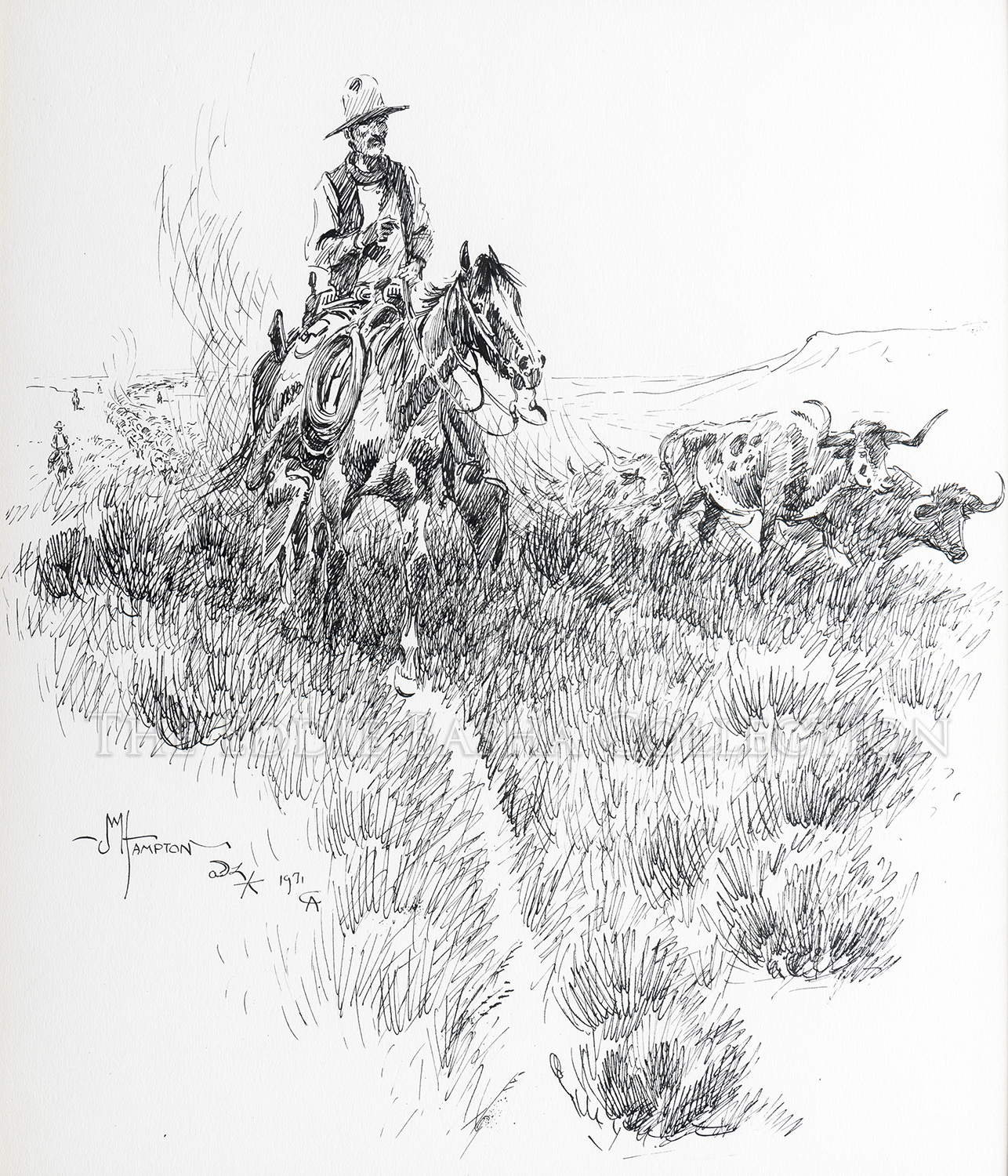
Up the Trail
Artist: John Hampton, CA Founding Member (1918-1999)
Description: Pen & Ink (1971) | Image Size: 16”h x 14”w; Framed Size: 27 1/4”h x 24 1/2”wdrawing
Cowboy Artists of America Founding Member John Hampton’s pen and ink presents with a cowboy leading a herd of longhorns across a sage covered prairie with distant mesas in the background. It is a completely realized scene, rather than a simple sketch or vignette.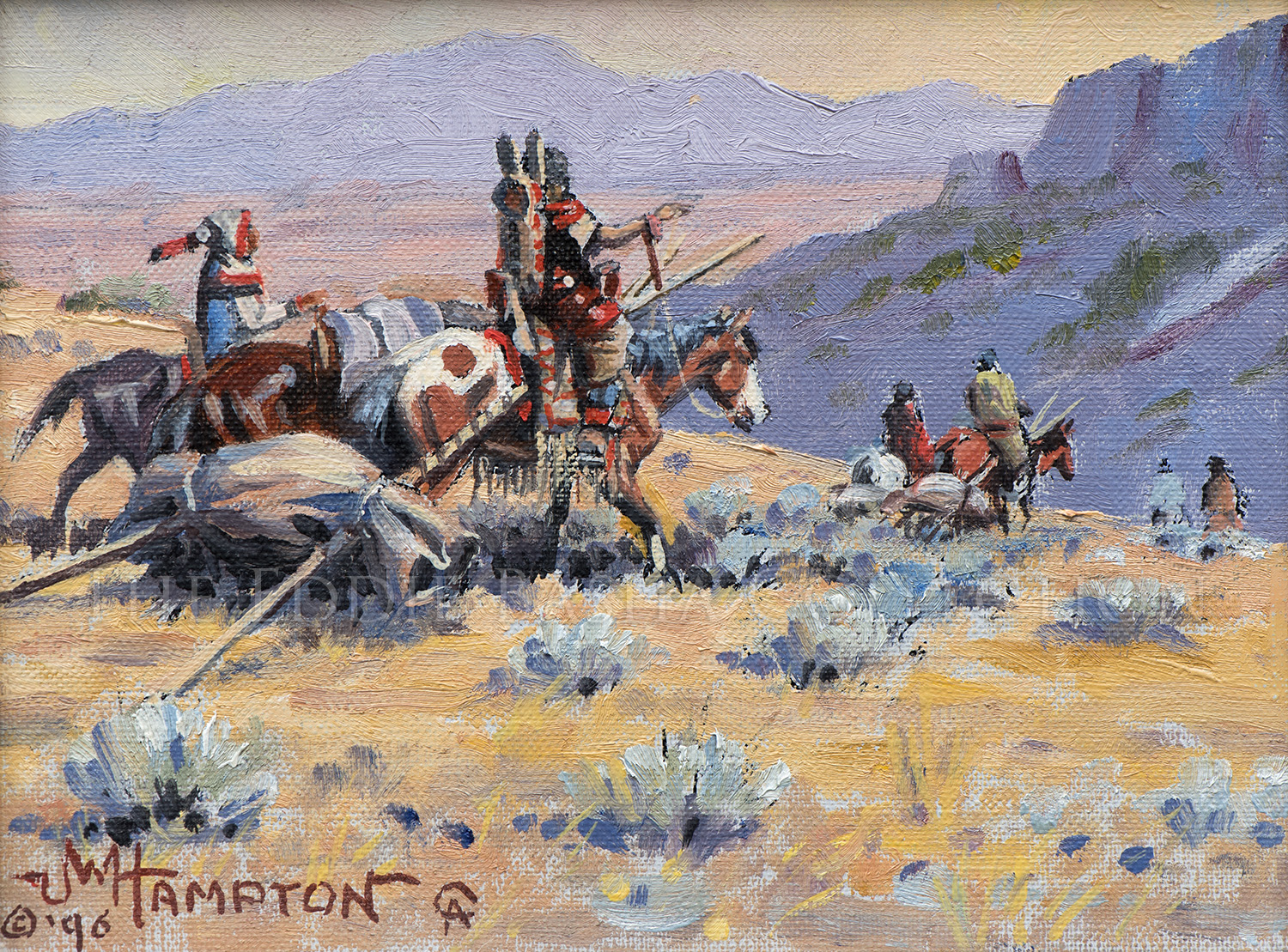
On The Move
Artist: John Hampton, CA Founding Member (1918-1999)
Description: Oil (1996) | Image Size: 6”h x 8”w; Framed Size: 10”h x 11 ½”wpainting
This miniature oil painting of a group of Indians moving camp most likely was completed as a study for a larger painting. Regardless, Founding Member of the Cowboy Artists of America, John Hampton, created a narrative with several authentic details of the nomadic nature of tribal life. Often a travois, a sort of sled utilizing two lodge poles that are bound together and pulled by horses, made the journey slightly easier. The figures in the painting are shown traveling in pairs from left to right across the canvas and diminish into the distance while the figures closest to the viewer in the left foreground are depicted in more detail.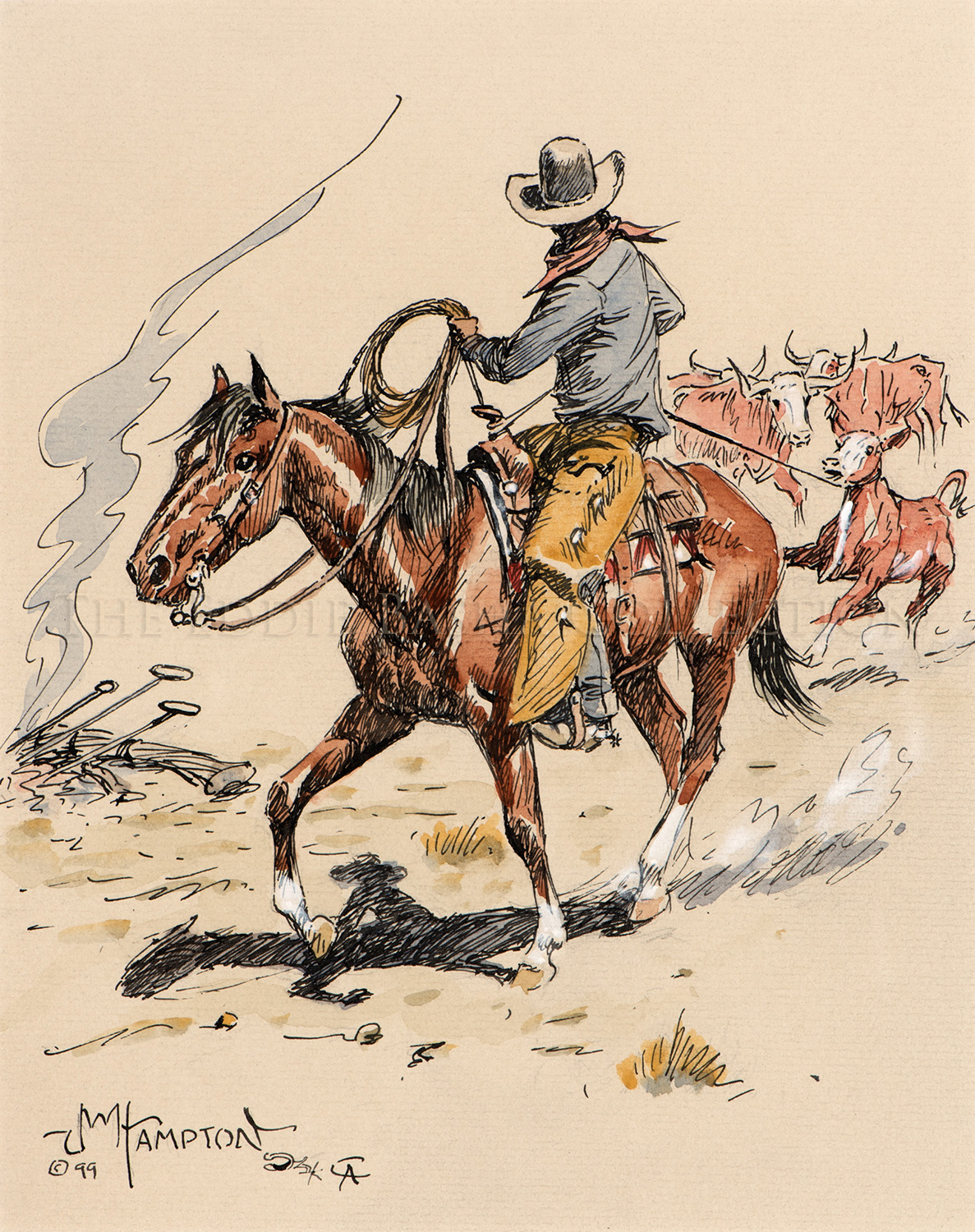
Trail Drive
Artist: John Hampton, CA Founding Member (1918-1999)
Description: Pen/Ink & Watercolor (1999) | Image Size: 10”h x 8”w; Framed Size: 17”h x 15”wdrawing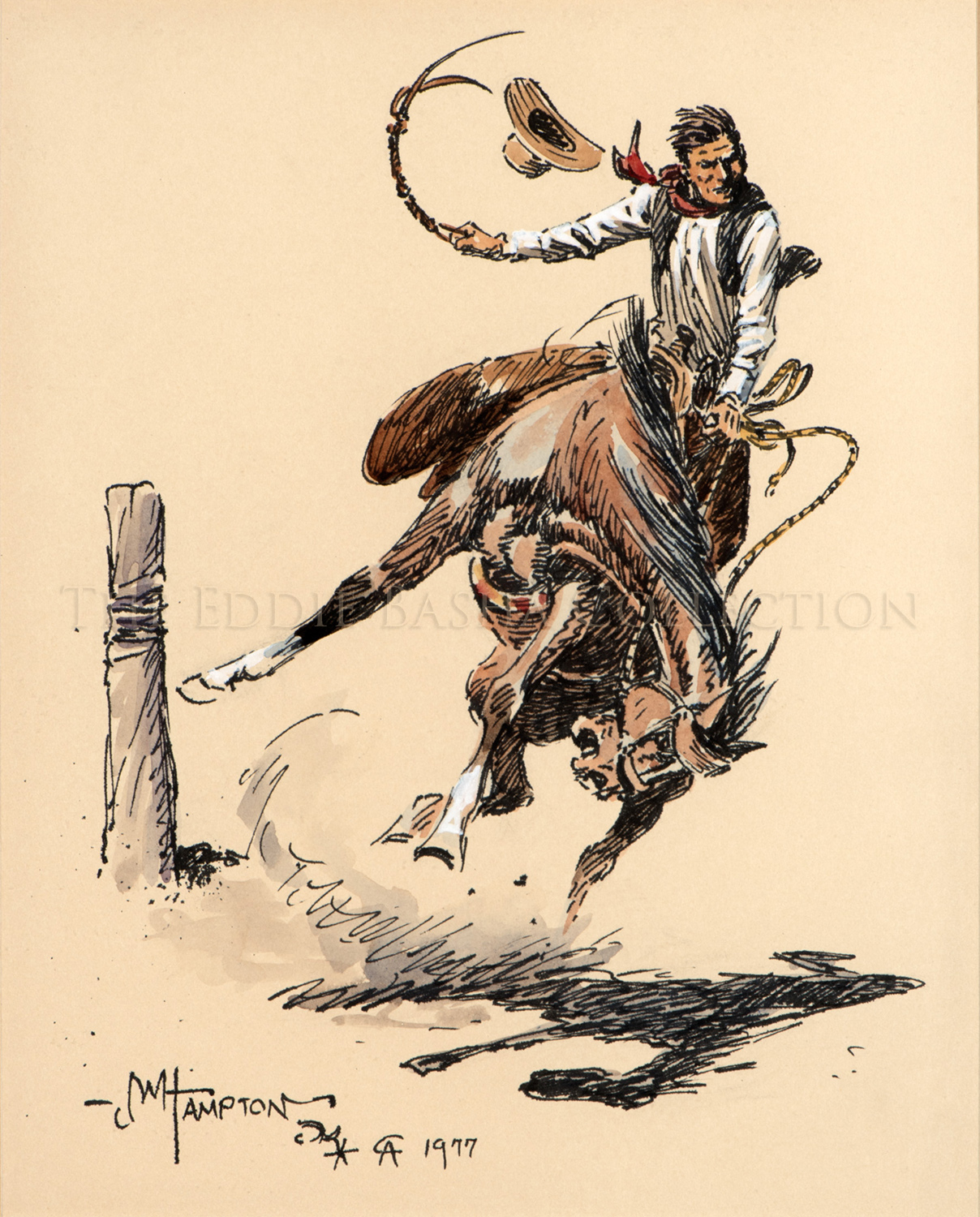
Unknown Title
Artist: John Hampton, CA Founding Member (1918-1999)
Description: Pen/Ink & Watercolor (1977) | Image Size: 10”h x 8”w; Framed Size: 17”h x 14 ½”wdrawing
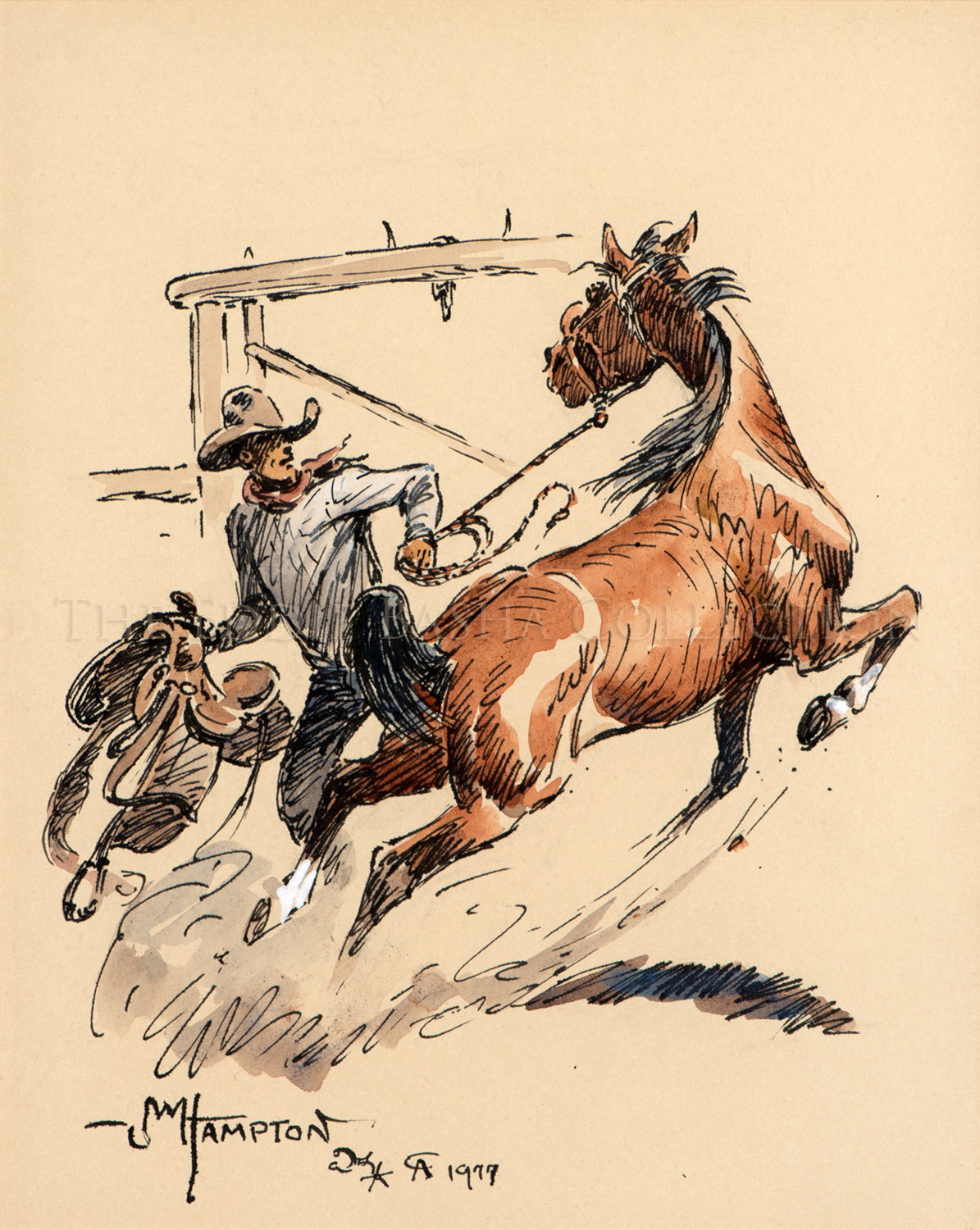
Unknown Title
Artist: John Hampton, CA Founding Member (1918-1999)
Description: Pen/Ink & Watercolor (1979) | Image Size: 10”h x 8”w; Framed Size: 17”h x 14 ½”wdrawing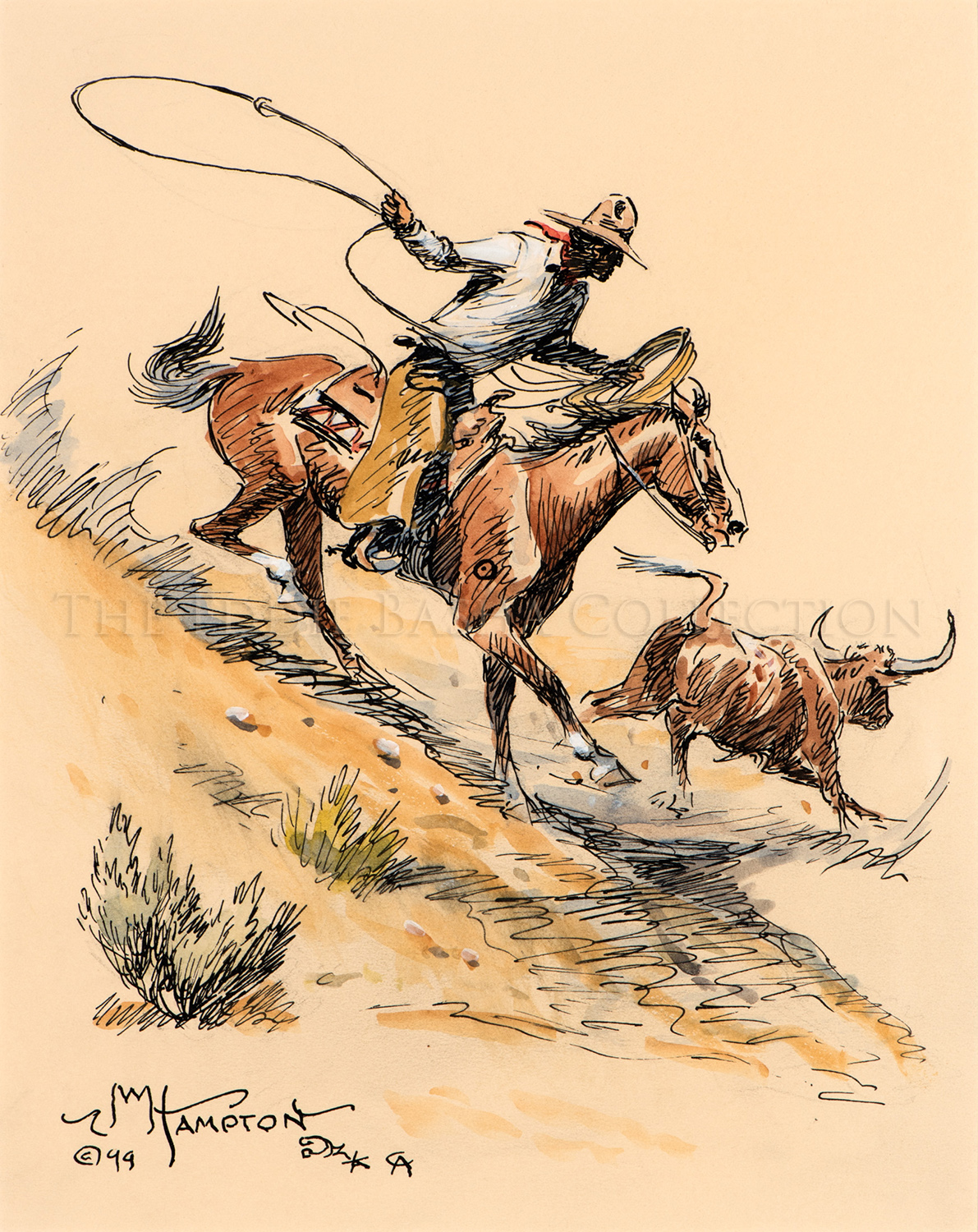
Unknown Title
Artist: John Hampton, CA Founding Member (1918-1999)
Description: Pen/Ink & Watercolor (1999) | Image Size: 10”h x 8”w; Framed Size: 17”h x 15”w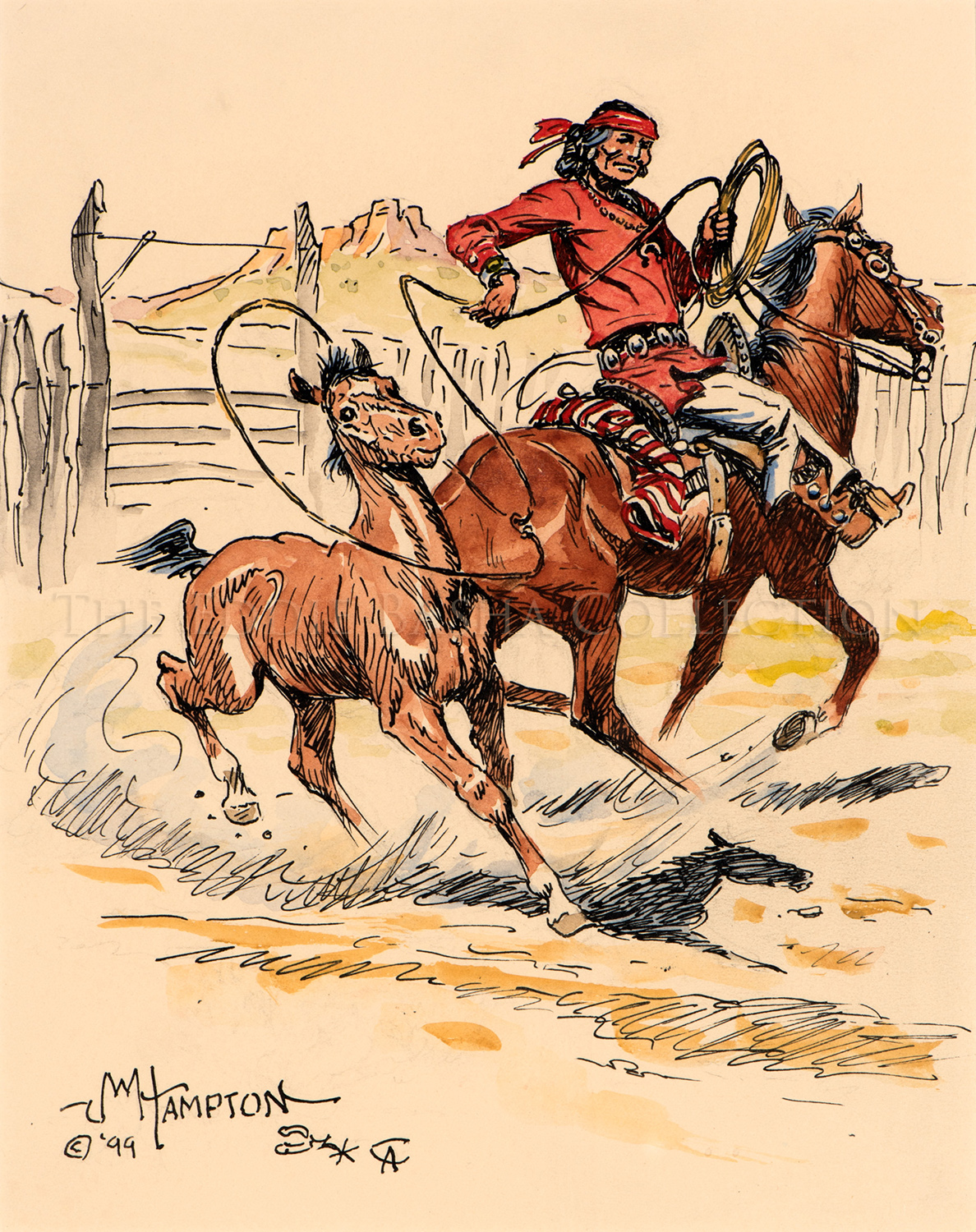
Navajo Roper
Artist: John Hampton, CA Founding Member (1918-1999)
Description: Pen/Ink & Watercolor (1999) | Image Size: 10”h x 8”w; Framed Size: 17”h x 15”wdrawing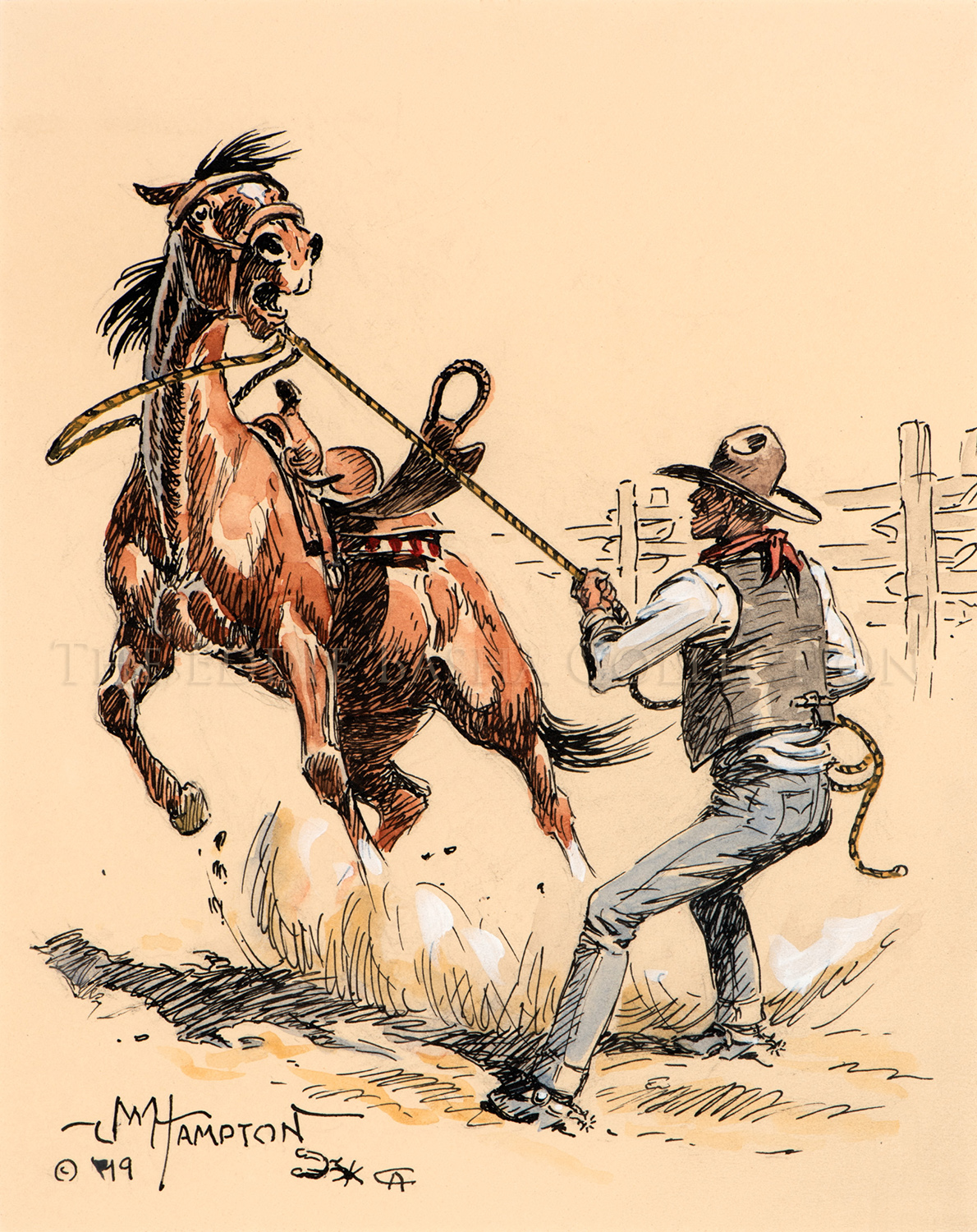
The Bronc
Artist: John Hampton, CA Founding Member (1918-1999)
Description: Pen/Ink & Watercolor (1999) | Image Size: 10”h x 8”w; Framed Size: 17” x 15”drawing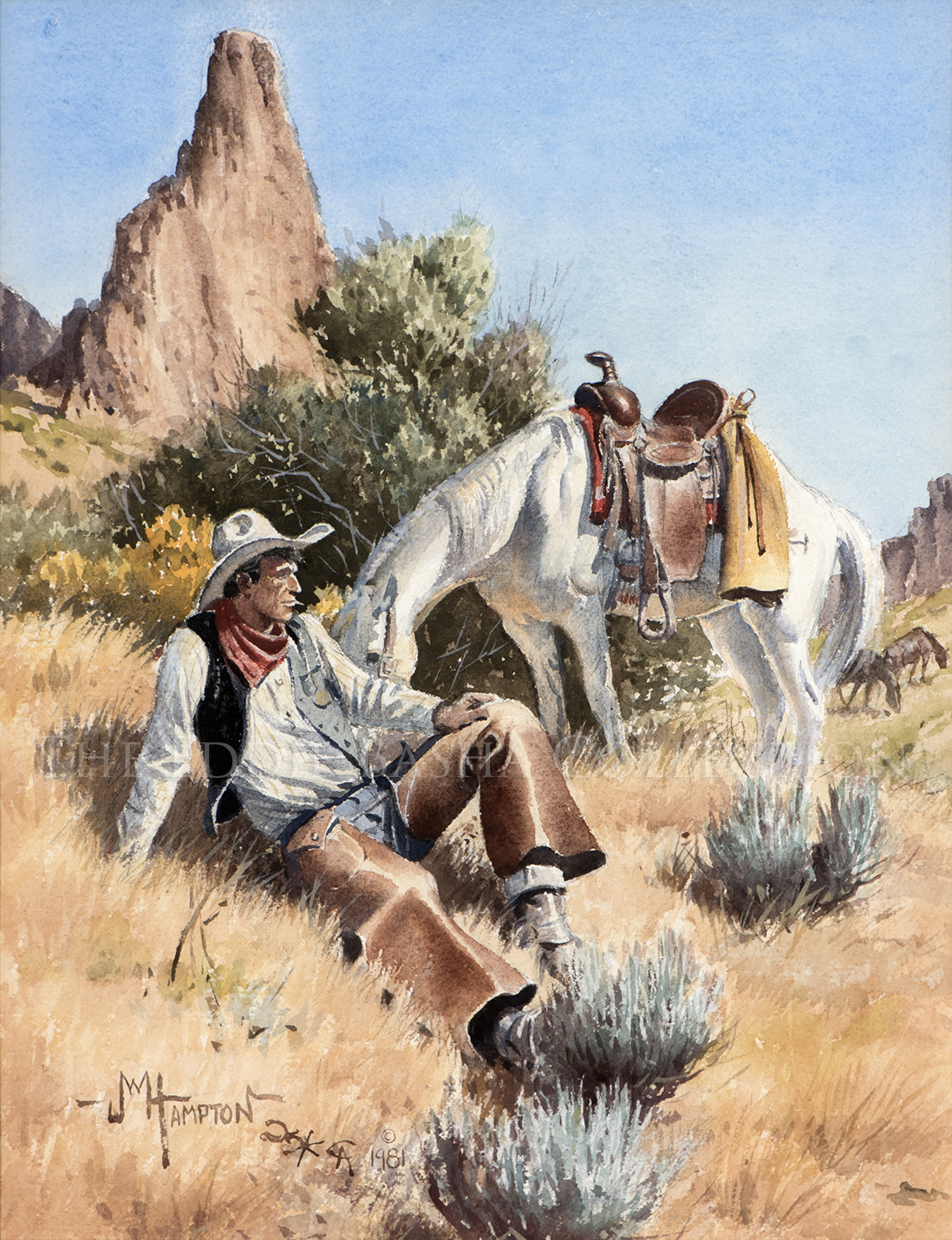
Sunshine Days
Artist: John Hampton, CA Founding Member (1918-1999)
Description: Watercolor (1981) | Image Size: 20”h x 15”w; Framed Size: 29 ½”h x 25”wpainting
This handsome watercolor of a cowboy taking respite during a sunshine-filled day demonstrates that though often his work involved dramatic and dangerous situations, there were plenty of quiet moments such as this one. As the cowboy lounges on the grass and sage covered ground, his still saddled horse munches beside him and the sun’s rays appear to rest upon the craggy peak’s surface behind as well.
“Sunshine Days” first appeared at the 16th Annual Cowboy Artists of America Show & Sale in 1981 and an image of it also appeared in the 1988 Cowboy Artists of America book authored by Catherine A Reynolds. While being interviewed for the book, John Hampton shared the following: “When asked about the name ‘Cowboy Artists’, I always joked that the cowboys called us artists, and the artists called us cowboys. Even though I’m the same breed as the cowboy, I chose the art. I remember a rancher once telling me, ‘Johnny, if you weren’t wasting your time doing that artwork, you’d make a pretty good cowboy’. Then one day he stood in back of me and watched me draw. He stood there about an hour, and said, ‘Your right, Johnny. If I could do that, I wouldn’t work either.’ Being an artist is not easy. The hard part is, you have to live up to the mystique you’ve created for yourself. That’s not easy to do all the time.”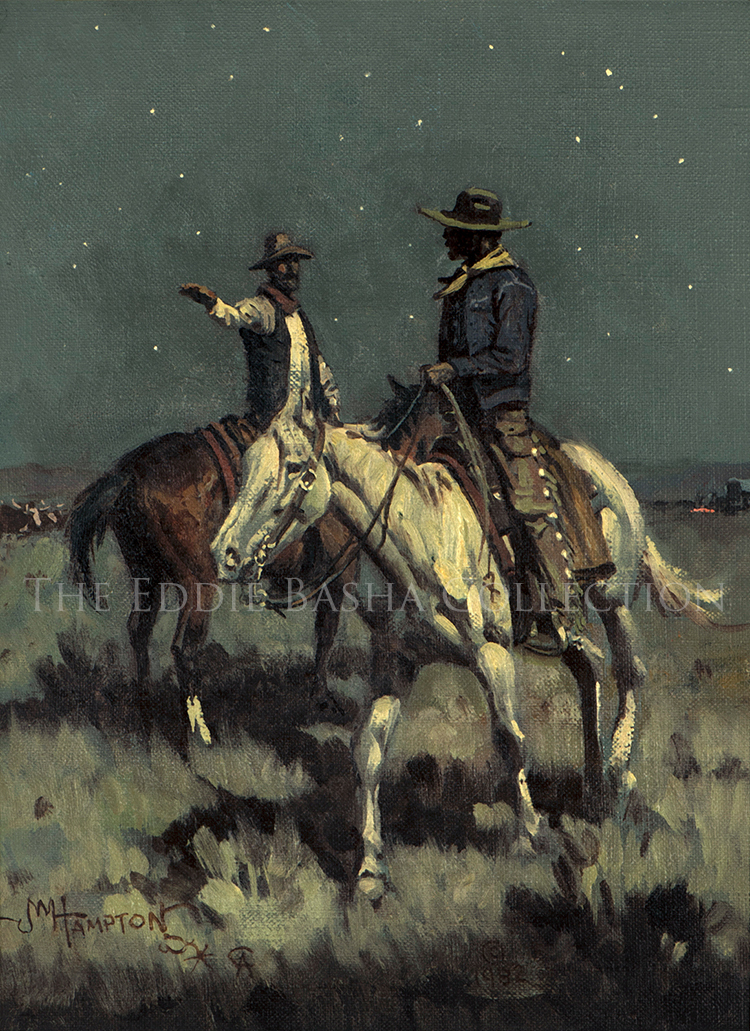
Changing the Night Guard
Artist: John Hampton, CA Founding Member (1918-1999)
Description: Oil (1982) | Image Size: 12”h x 9”w; Framed Size: 18”h x 14”wpainting
The most pervasive element of this small painting is the glow of the moonlight that permeates the entire scene as two cowboys pass one another. One is headed back to camp and the other is headed toward the cattle herd to take his turn as the night guard.
It is a simple and quiet scene of cowboy life painted with subdued colors and tones. Hampton conveys a peaceful mood by emphasizing the moonlight upon the horses and men. The lighting is reflected by the coat of the white horse and the pale ground.
In 2015 this piece was shown at the Commemorative Exhibition of the “Cowboy Artists of America: The 50-Year Roundup” at the Sedona Arts Center and again in 2017 at the Phippen Museum’s “By the Light of the Moon” exhibition.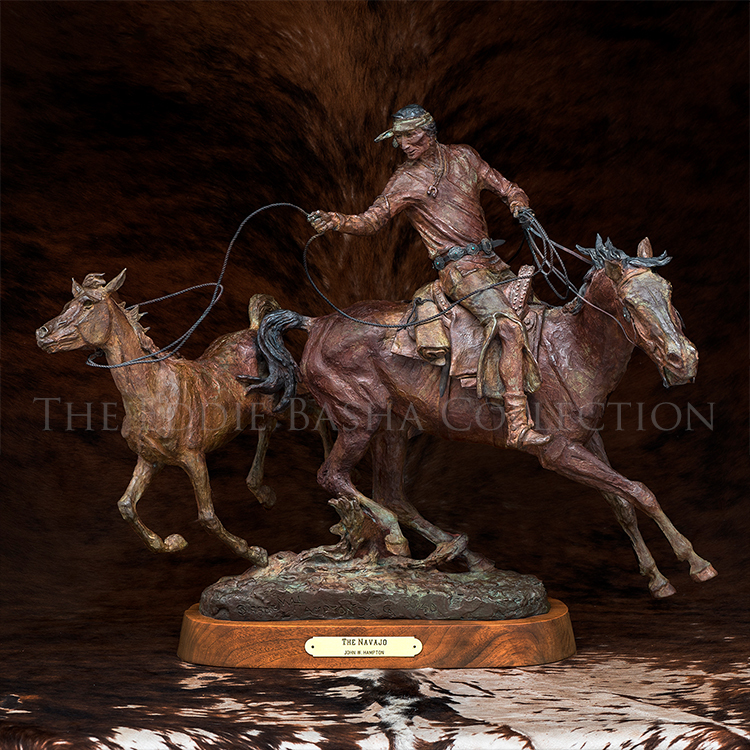
The Navajo
Artist: John Hampton, CA Founding Member (1918-1999)
Description: Bronze (1980) | Dimensions: 20”h x 26”w x 14”d; Edition #30 of 40bronze
This ambitious bronze is one of Hampton’s most accomplished pieces. The richly colored patina adds to the heightened sense of drama and motion. Hampton shows a firm grasp of the highly respected horsemanship skills of the Navajo, his ability to tell a story and his technical skill at balancing the figures on a small base. “The Navajo” received the Gold Medal in Sculpture at the 15th Annual Cowboy Artists of America Show & Sale held at the Phoenix Art Museum in 1980.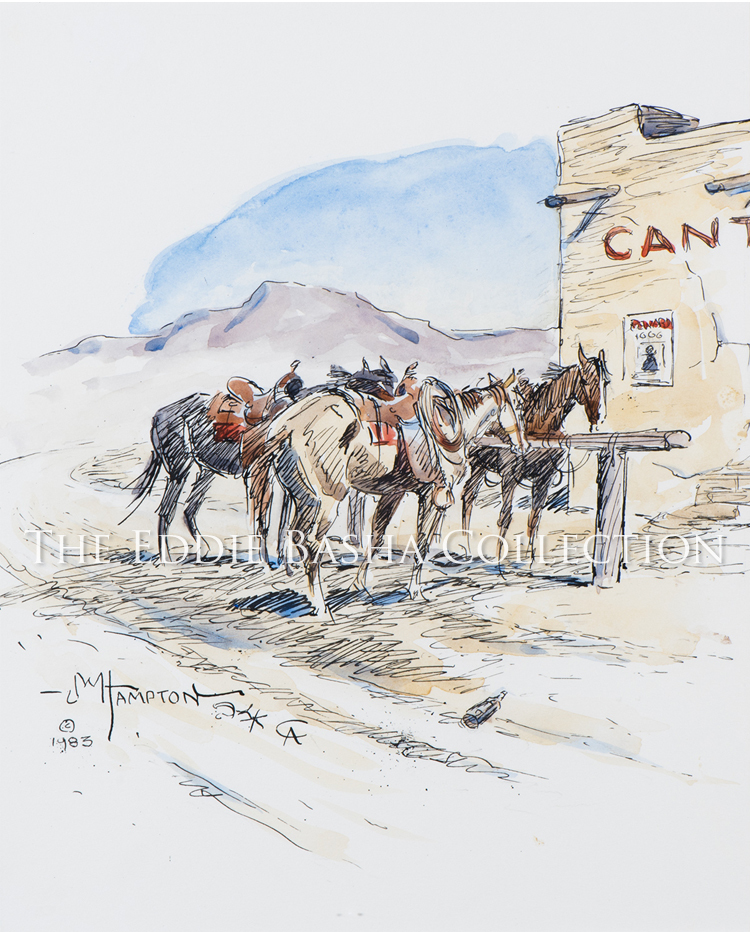
At the Cantina
Artist: John Hampton, CA Founding Member (1918-1999)
Description: Pen/Ink & Watercolor (1983) | Image Size: 10”h x 8”w; Framed Size: 18”h x 15 3/8”wdrawing
John Hampton’s artistic roots began during his youth in Brooklyn where if he wasn’t drawing, he was roping imaginary cattle or stationery items such as fire hydrants with his mother’s clothesline. As a teen, an art contest win in 1935 led to lucrative employment as a pulp fiction and comic strip illustrator which helped him garner the funds to move west where he continued his artistic endeavors following his years serving in Intelligence during World War II.
Later, in 1965, he and three other artists founded the prestigious Cowboy Artists of America. And though John Hampton’s artistic capabilities expanded and grew throughout the years to include oil painting and sculpting, his illustrative style drawings/watercolors remained a staple throughout his career as a professional fine artist as evidenced by this 1983 piece “At the Cantina.”
KRYSTLE: Replace current website image on all landing pages, collection and artist. This is a newer image and it has better clarity. Thank you.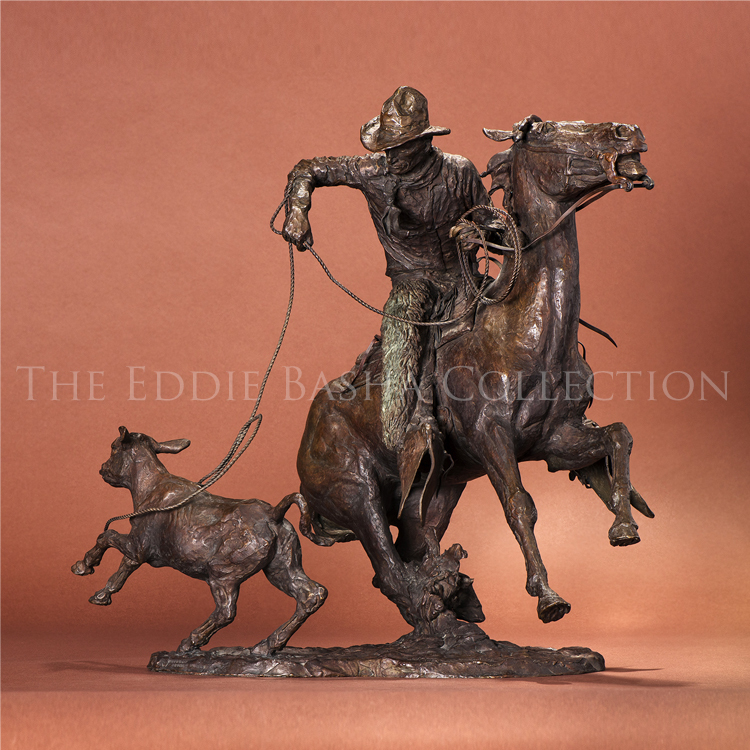
Throwing the Hooley-Ann
Artist: John Hampton, CA Founding Member (1918-1999)
Description: Bronze (1977) | 18”h x 19”w x 14”d; Edition #7 of 25bronze
One of the first bronze sculptures Cowboy Artists of America founding member John Hampton cast, “Throwing the Hooley-Ann,” is reflective of his natural facility with the medium as well as the subject matter. This piece won John the gold medal in sculpture at the 1977 CAA Exhibition & Sale held at the Phoenix Art Museum. It also set the standard for much of his subsequent work. For those not so in the know, a hooley-ann is a well-spread thrown loop that settles from above on its objective.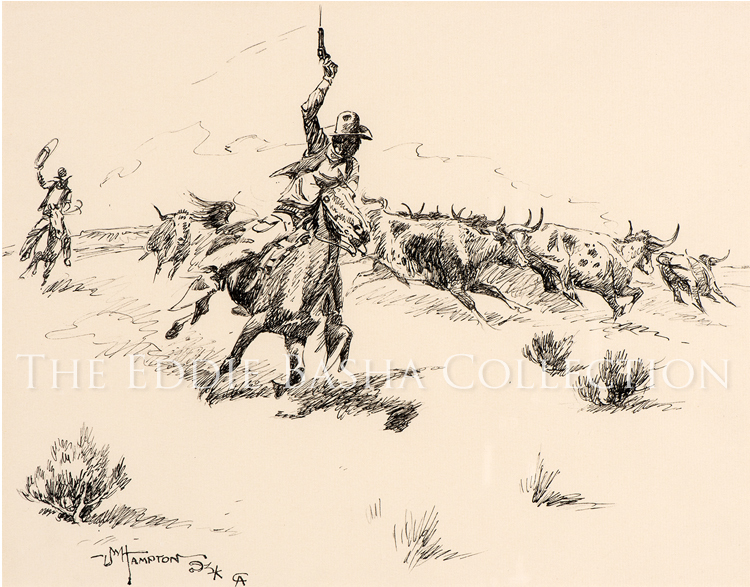
Turning the Leader
Artist: John Hampton, CA Founding Member (1918-1999)
Description: Pen & Ink | Image Size: 11”h x 14”w; Framed Size: 19 3/8”h x 22 3/8”wdrawing
A founding member of the Cowboy Artists of America, John Hampton frequently focused his attention on the actual work of a cowboy. In scenes such as this one of two cowboys frantically turning a stampeding herd of longhorn cattle, he succeeded in capturing the drama and excitement of the moment as well as the perilous labors a cowboy often endures.
This piece was previously exhibited April 16, 1985 - January 22, 1986, at the then called Cowboy Artist of America Museum in Kerrville, Texas. The Museum is now known as the Museum of Western Art.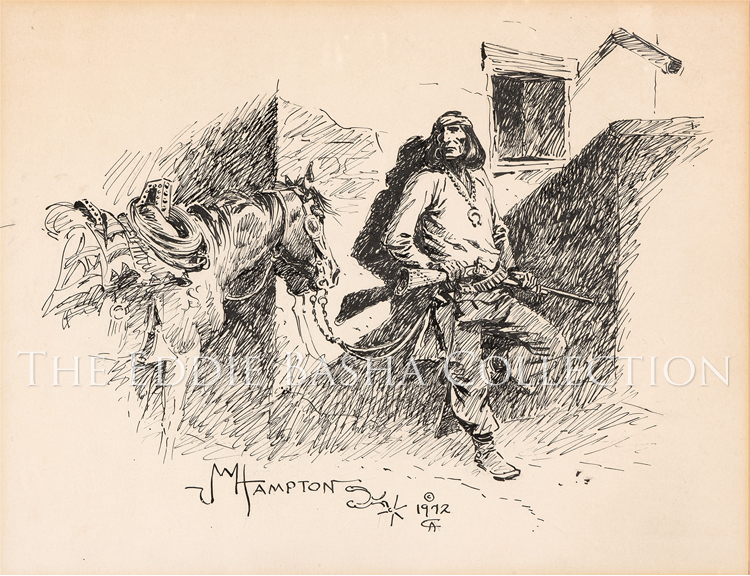
Navajo Night Guard
Artist: John Hampton, CA Founding Member (1918-1999)
Description: Pen & Ink (1972) | Image Size: 12”h x 14”w; Framed Size: 18 1/8”h x 21 1/8”wdrawing
Like many of his contemporaries among western artists, Hampton was adept at setting the stage of an unfolding story. His drawing of an Indian standing guard outside of an adobe dwelling was executed with deft strokes and a sure hand. Seven years in, John Hampton brought this gem to the 7th Annual CAA Exhibition & Sale held at the National Cowboy & Western Heritage Museum in Oklahoma City, Oklahoma.
John Hampton, one of the founders of the Cowboy Artists of America was still painting, drawing, and sculpting the many stories of the American West well into his eighties. Born in Brooklyn, New York, but moved west early on. As a boy, he had shown an early aptitude for art and won a drawing contest sponsored by the New York World Telegram. Years later, while he was working as a cowboy in New Mexico, one of his cow bosses told him that he had the makings of a good cowboy, but an even better artist. Hampton combined those two pursuits for the rest of his life. One of his early jobs was working as an illustrator for newspaper comic strips, including Fred Harman’s Red Ryder and Little Beaver.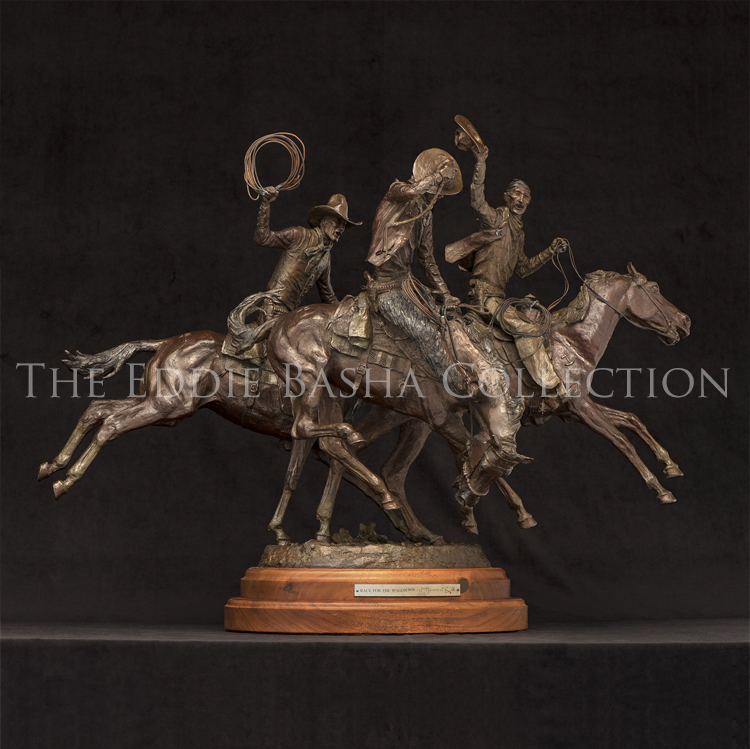
Race for the Wagon
Artist: John Hampton, CA Founding Member (1918-1999)
Description: Bronze (1982) | Dimensions: 24.5”h x 41”w x 16”d; Edition #30 of 50bronze
In the small yard in his Brooklyn boyhood home, John Wade Hampton practiced roping cows with his mother’s clothesline. With earning from the “Red Ryder” comic strip, which he helped draw, Hampton moved West to Scottsdale, for a time, where he raised and punched a few head – mostly as models for his art – and helped found the Cowboy Artists of America. In the mode of Remington’s Coming Through the Rye and countless others, Race for the Wagon is Hampton’s entry in the “hell bent for leather” Western bronze motif, whose unstated goal seems to be to make the cowboys and horses appear to fly as if on air. Hampton’s nifty solution anchors the rear legs of the front horses and the front legs of the rearmost horse on a small round base so that at least half of each horse is unsupported. Having the horse nearest us bow his head allows us to see through the composition. The cowboys seem to levitate between strides.
In this action-packed bronze, John Hampton, showed off his sculpting skills by expertly capturing three cowboys letting off steam as they raced for the chuck wagon. Hampton imbued his sculpture with frenetic action and simultaneously achieved a delicate balance by seemingly suspending the riders in mid-air. Viewers are often so focused on the action and interplay of the riders that the skill of balancing all of the figures may be overlooked. This bronze won the Silver Medal in sculpture at the 1982 Cowboy Artists of America Exhibition & Sale.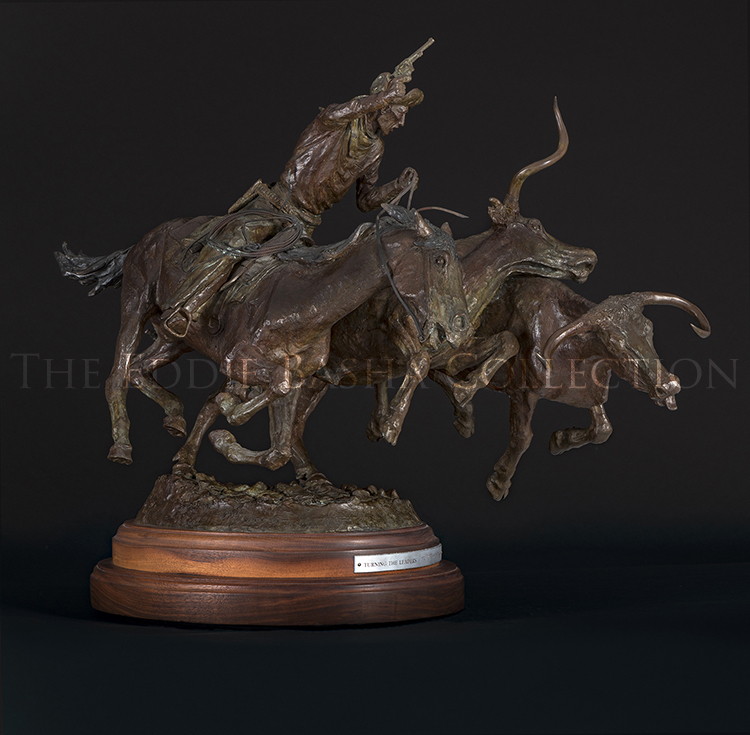
Turning the Leaders
Artist: John Hampton, CA Founding Member (1918-1999)
Description: Bronze (1981) | Dimensions: 30”h x 20”w x 18”d; Edition #30 of 55bronze
Maneuvering in front of two charging longhorn steers at the front of a stampede is one of the most dangerous tasks that early cowboys faced in their long trail drives to Kansas railheads or open ranges of Montana. The task required strength, agility, and courage on the part of the cowhand and his horse. More than a few cowboys were felled trying to turn a stampeding herd.
John Hampton, the artist, depicted not only the perilous danger but also the mid-air action of the rider, his horse and the steers in full gallop. With its deep golden brown and green patinas, this piece is a masterful evocation of the drama of the Old West and was awarded the Sculpture Gold Medal at the Cowboy Artists of America Exhibition & Sale in 1981.
Trade Talk
Artist: John Hampton, CA Founding Member (1918-1999)
Description: Pen & Ink (1971) | Image Size: 12”h x 18”w; Framed Size: 18 ¼”h x 25 ¼”wdrawing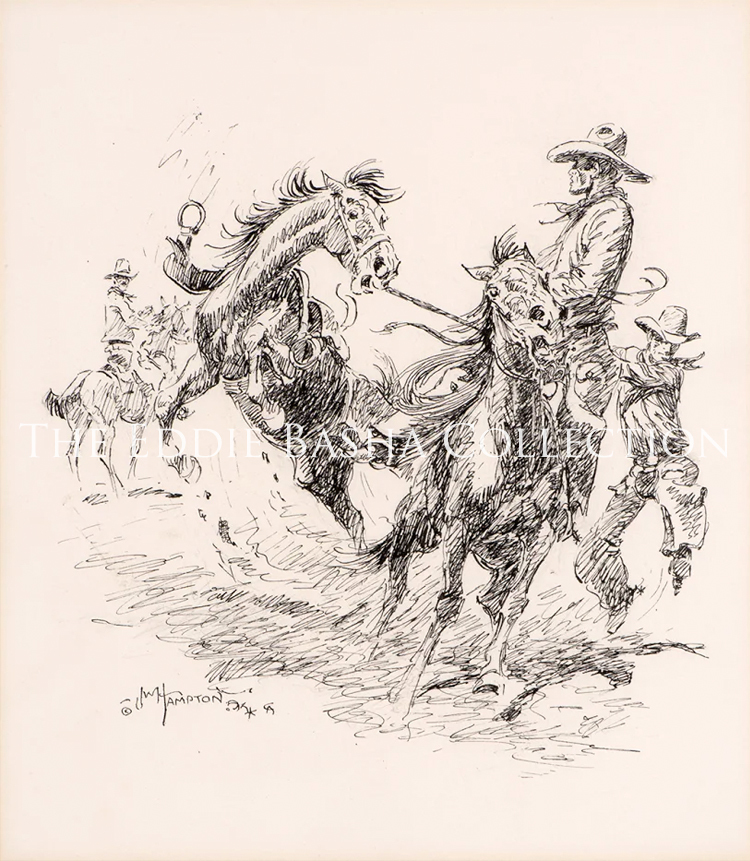
Pick-Up Man
Artist: John Hampton, CA Founding Member (1918-1999)
Description: Pen & Ink | Image Size: 16”h x 14”w; Framed Size: 24 1/8”H X 22 1/8”Wdrawing
As a young artist, John Hampton assisted Fred Harman with drawings for the Red Ryder comic strip and developed a knack for these type of pen and ink vignettes on various aspects of western life.
Pick-Up Man refers to the cowhand whose job was to provide a safe haven for a rider who had just been bucked off of a bronco. We’ve all been bucked off the saddle a time or two; regardless of whether it was literally or figuratively it always smarts a little.
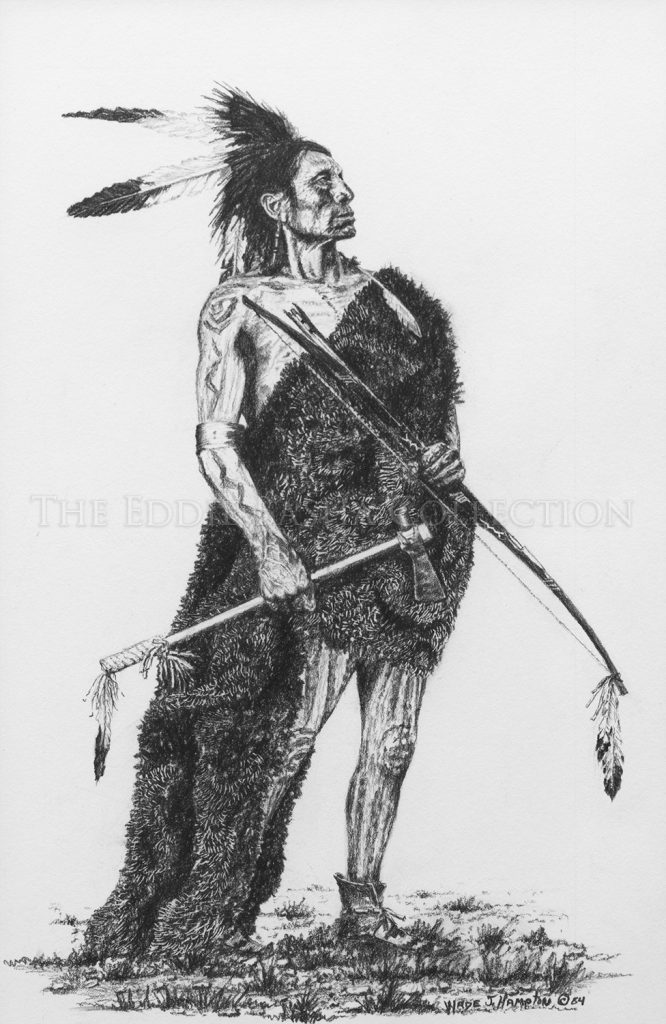 Pencil (1984) | Image Size: 12”h x 8”w; Frame Size: 18”h x 14”w
Pencil (1984) | Image Size: 12”h x 8”w; Frame Size: 18”h x 14”wAn atypical pencil drawing by CA Founding Member, John Wade Hampton, signed Wade J. Hampton, depicts a full body portrait of a buffalo robe swaddled Indian looking off stoically to the distant right with a bow and arrow in his left hand and a long-handled hatchet in his right. This piece is more reminiscent stylistically to that of a Karl Bodmer drawing. Perhaps it is the reason he signed this and other similar pieces to it differently than he normally would sign his work.
Unknown Title
Artist: John Hampton, CA Founding Member (1918-1999)
An atypical pencil drawing by CA Founding Member, John Wade Hampton, signed Wade J. Hampton, depicts a full body portrait of a buffalo robe swaddled Indian looking off stoically to the distant right with a bow and arrow in his left hand and a long-handled hatchet in his right. This piece is more reminiscent stylistically to that of a Karl Bodmer drawing. Perhaps it is the reason he signed this and other similar pieces to it differently than he normally would sign his work.
 Pen & Ink (1996) | Image Size: 10”h x 13 ½”w; Framed Size: 19 1/2”h x 22 1/2”w
Pen & Ink (1996) | Image Size: 10”h x 13 ½”w; Framed Size: 19 1/2”h x 22 1/2”wHoned over several years, Cowboy Artists of America Founding Member John Hampton was skilled as a draftsman who could draw almost any facet of cowboy life such as this drawing of a cowhand roping a wayward steer while at full gallop on his horse. With an economy of strokes, Hampton presents a realistic vignette of western action.
Trail Drive
Artist: John Hampton, CA Founding Member (1918-1999)
Honed over several years, Cowboy Artists of America Founding Member John Hampton was skilled as a draftsman who could draw almost any facet of cowboy life such as this drawing of a cowhand roping a wayward steer while at full gallop on his horse. With an economy of strokes, Hampton presents a realistic vignette of western action.
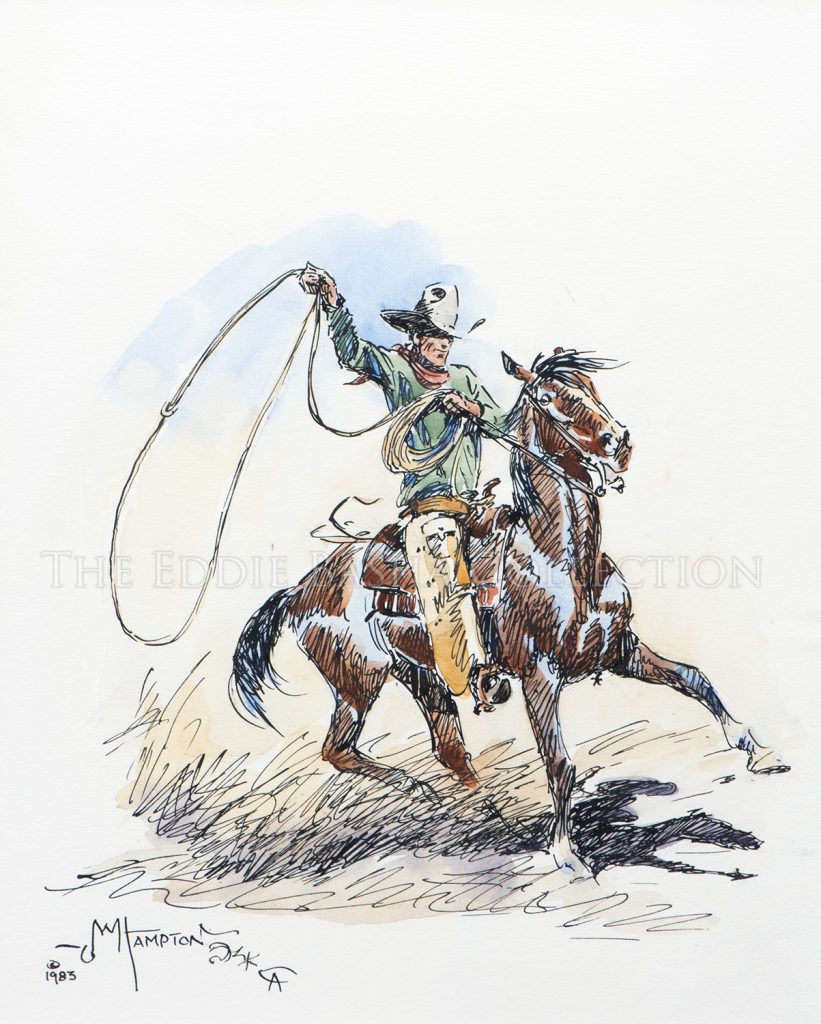 Pen, Ink & Watercolor (1983) | Image Size: 10”h x 8”w; Framed Size: 18”h x 15 ½”w
Pen, Ink & Watercolor (1983) | Image Size: 10”h x 8”w; Framed Size: 18”h x 15 ½”w A cowboy’s hungry loop is intended for a cow, a colt or whatever he or she is focused on lassoing. It has been featured in many a western artist’s body of work just as John Hampton, Cowboy Artist of America Founding Member, has depicted here.
A Hungry Loop
Artist: John Hampton, CA Founding Member (1918-1999)
A cowboy’s hungry loop is intended for a cow, a colt or whatever he or she is focused on lassoing. It has been featured in many a western artist’s body of work just as John Hampton, Cowboy Artist of America Founding Member, has depicted here.
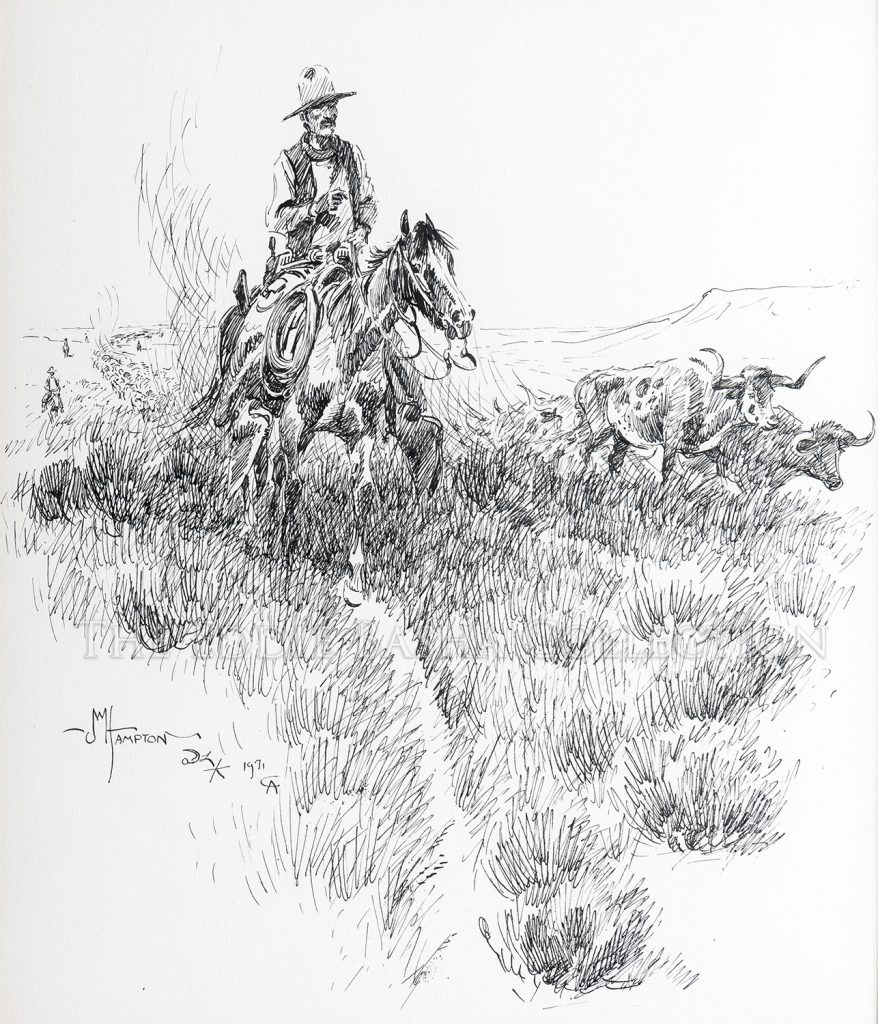 Pen & Ink (1971) | Image Size: 16”h x 14”w; Framed Size: 27 1/4”h x 24 1/2”w
Pen & Ink (1971) | Image Size: 16”h x 14”w; Framed Size: 27 1/4”h x 24 1/2”wCowboy Artists of America Founding Member John Hampton’s pen and ink presents with a cowboy leading a herd of longhorns across a sage covered prairie with distant mesas in the background. It is a completely realized scene, rather than a simple sketch or vignette.
Up the Trail
Artist: John Hampton, CA Founding Member (1918-1999)
Cowboy Artists of America Founding Member John Hampton’s pen and ink presents with a cowboy leading a herd of longhorns across a sage covered prairie with distant mesas in the background. It is a completely realized scene, rather than a simple sketch or vignette.
 Oil (1996) | Image Size: 6”h x 8”w; Framed Size: 10”h x 11 ½”w
Oil (1996) | Image Size: 6”h x 8”w; Framed Size: 10”h x 11 ½”w This miniature oil painting of a group of Indians moving camp most likely was completed as a study for a larger painting. Regardless, Founding Member of the Cowboy Artists of America, John Hampton, created a narrative with several authentic details of the nomadic nature of tribal life. Often a travois, a sort of sled utilizing two lodge poles that are bound together and pulled by horses, made the journey slightly easier. The figures in the painting are shown traveling in pairs from left to right across the canvas and diminish into the distance while the figures closest to the viewer in the left foreground are depicted in more detail.
On The Move
Artist: John Hampton, CA Founding Member (1918-1999)
This miniature oil painting of a group of Indians moving camp most likely was completed as a study for a larger painting. Regardless, Founding Member of the Cowboy Artists of America, John Hampton, created a narrative with several authentic details of the nomadic nature of tribal life. Often a travois, a sort of sled utilizing two lodge poles that are bound together and pulled by horses, made the journey slightly easier. The figures in the painting are shown traveling in pairs from left to right across the canvas and diminish into the distance while the figures closest to the viewer in the left foreground are depicted in more detail.
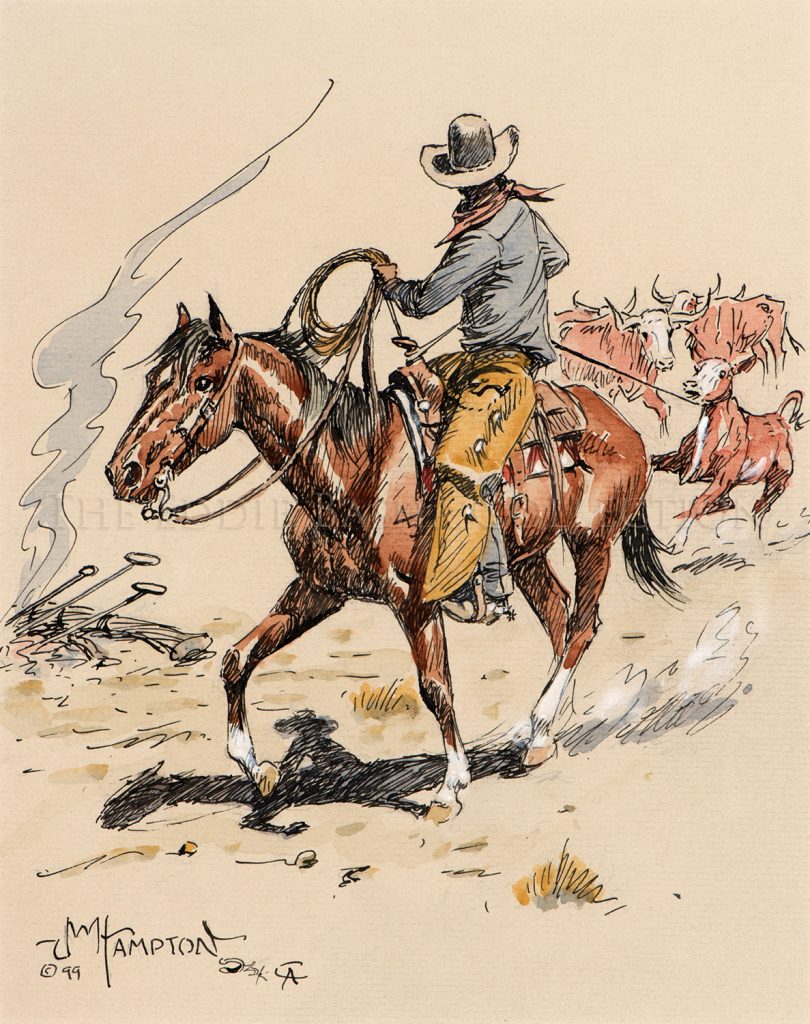 Pen/Ink & Watercolor (1999) | Image Size: 10”h x 8”w; Framed Size: 17”h x 15”w
Pen/Ink & Watercolor (1999) | Image Size: 10”h x 8”w; Framed Size: 17”h x 15”wTrail Drive
Artist: John Hampton, CA Founding Member (1918-1999)
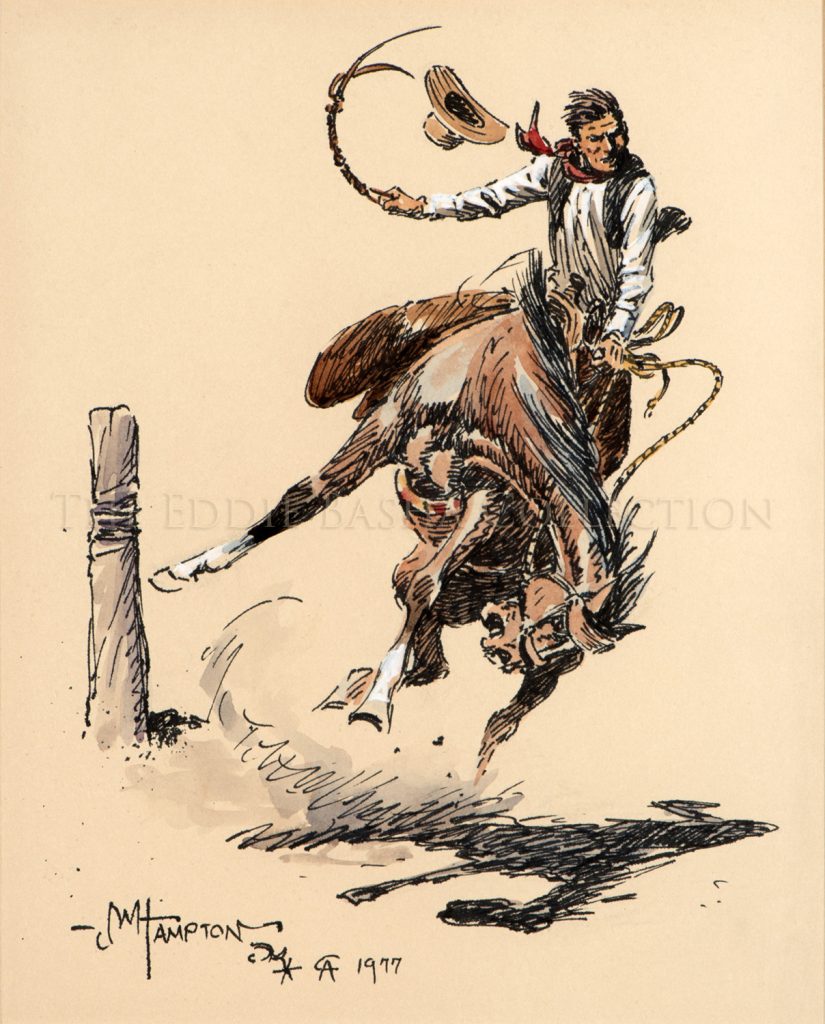 Pen/Ink & Watercolor (1977) | Image Size: 10”h x 8”w; Framed Size: 17”h x 14 ½”w
Pen/Ink & Watercolor (1977) | Image Size: 10”h x 8”w; Framed Size: 17”h x 14 ½”wUnknown Title
Artist: John Hampton, CA Founding Member (1918-1999)
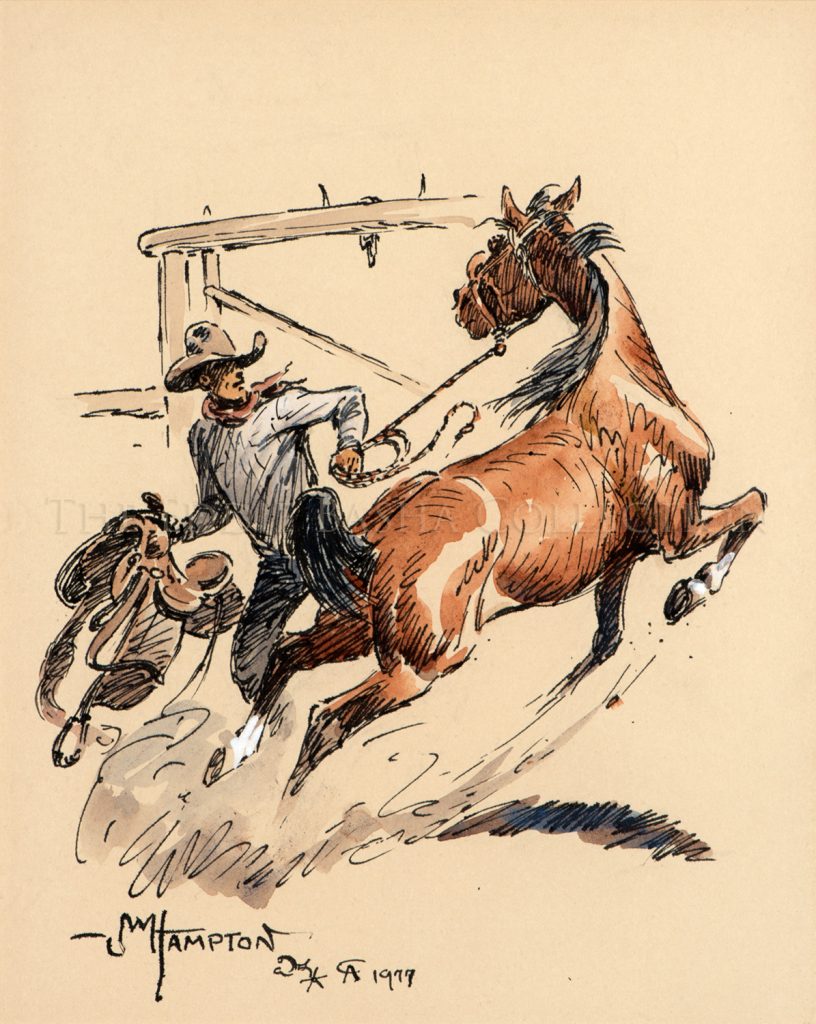 Pen/Ink & Watercolor (1979) | Image Size: 10”h x 8”w; Framed Size: 17”h x 14 ½”w
Pen/Ink & Watercolor (1979) | Image Size: 10”h x 8”w; Framed Size: 17”h x 14 ½”wUnknown Title
Artist: John Hampton, CA Founding Member (1918-1999)
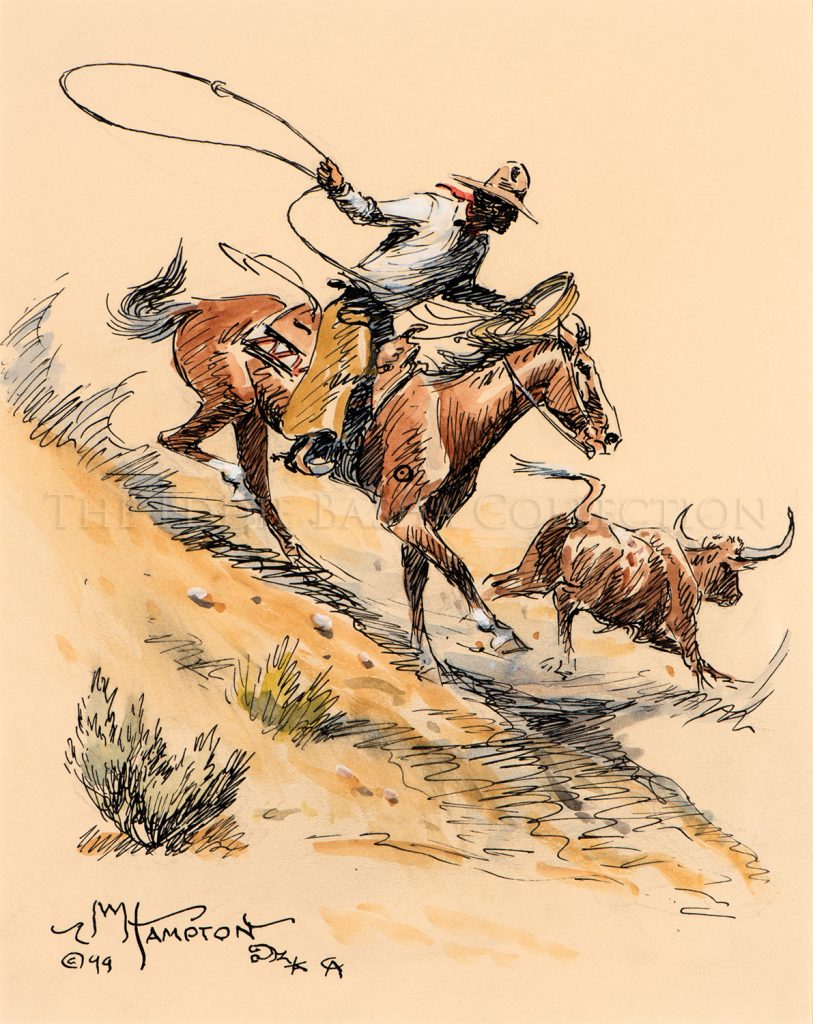 Pen/Ink & Watercolor (1999) | Image Size: 10”h x 8”w; Framed Size: 17”h x 15”w
Pen/Ink & Watercolor (1999) | Image Size: 10”h x 8”w; Framed Size: 17”h x 15”wUnknown Title
Artist: John Hampton, CA Founding Member (1918-1999)
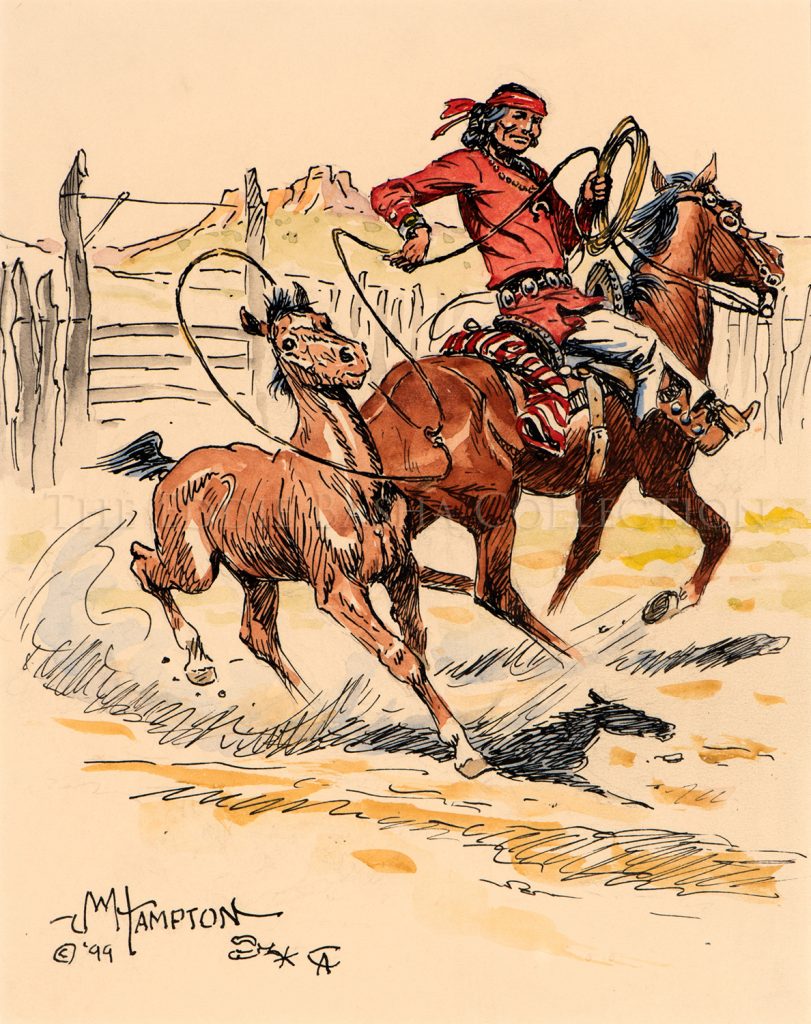 Pen/Ink & Watercolor (1999) | Image Size: 10”h x 8”w; Framed Size: 17”h x 15”w
Pen/Ink & Watercolor (1999) | Image Size: 10”h x 8”w; Framed Size: 17”h x 15”wNavajo Roper
Artist: John Hampton, CA Founding Member (1918-1999)
 Pen/Ink & Watercolor (1999) | Image Size: 10”h x 8”w; Framed Size: 17” x 15”
Pen/Ink & Watercolor (1999) | Image Size: 10”h x 8”w; Framed Size: 17” x 15”The Bronc
Artist: John Hampton, CA Founding Member (1918-1999)
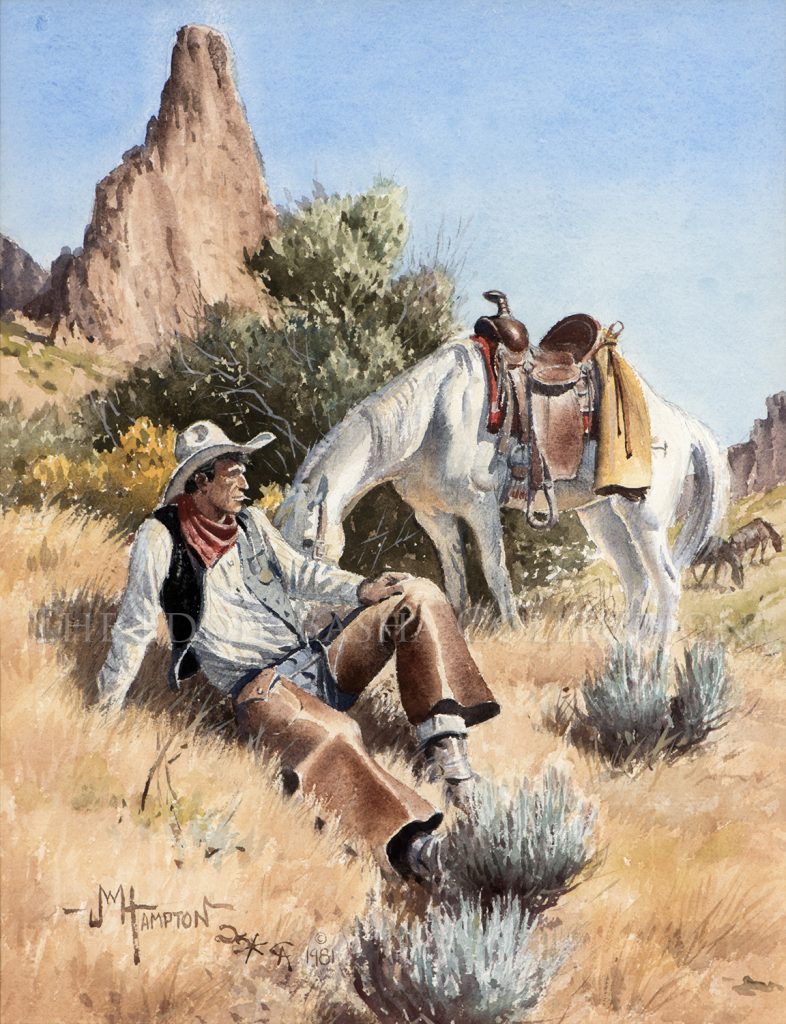 Watercolor (1981) | Image Size: 20”h x 15”w; Framed Size: 29 ½”h x 25”w
Watercolor (1981) | Image Size: 20”h x 15”w; Framed Size: 29 ½”h x 25”wThis handsome watercolor of a cowboy taking respite during a sunshine-filled day demonstrates that though often his work involved dramatic and dangerous situations, there were plenty of quiet moments such as this one. As the cowboy lounges on the grass and sage covered ground, his still saddled horse munches beside him and the sun’s rays appear to rest upon the craggy peak’s surface behind as well.
“Sunshine Days” first appeared at the 16th Annual Cowboy Artists of America Show & Sale in 1981 and an image of it also appeared in the 1988 Cowboy Artists of America book authored by Catherine A Reynolds. While being interviewed for the book, John Hampton shared the following: “When asked about the name ‘Cowboy Artists’, I always joked that the cowboys called us artists, and the artists called us cowboys. Even though I’m the same breed as the cowboy, I chose the art. I remember a rancher once telling me, ‘Johnny, if you weren’t wasting your time doing that artwork, you’d make a pretty good cowboy’. Then one day he stood in back of me and watched me draw. He stood there about an hour, and said, ‘Your right, Johnny. If I could do that, I wouldn’t work either.’ Being an artist is not easy. The hard part is, you have to live up to the mystique you’ve created for yourself. That’s not easy to do all the time.”
Sunshine Days
Artist: John Hampton, CA Founding Member (1918-1999)
This handsome watercolor of a cowboy taking respite during a sunshine-filled day demonstrates that though often his work involved dramatic and dangerous situations, there were plenty of quiet moments such as this one. As the cowboy lounges on the grass and sage covered ground, his still saddled horse munches beside him and the sun’s rays appear to rest upon the craggy peak’s surface behind as well.
“Sunshine Days” first appeared at the 16th Annual Cowboy Artists of America Show & Sale in 1981 and an image of it also appeared in the 1988 Cowboy Artists of America book authored by Catherine A Reynolds. While being interviewed for the book, John Hampton shared the following: “When asked about the name ‘Cowboy Artists’, I always joked that the cowboys called us artists, and the artists called us cowboys. Even though I’m the same breed as the cowboy, I chose the art. I remember a rancher once telling me, ‘Johnny, if you weren’t wasting your time doing that artwork, you’d make a pretty good cowboy’. Then one day he stood in back of me and watched me draw. He stood there about an hour, and said, ‘Your right, Johnny. If I could do that, I wouldn’t work either.’ Being an artist is not easy. The hard part is, you have to live up to the mystique you’ve created for yourself. That’s not easy to do all the time.”
 Oil (1982) | Image Size: 12”h x 9”w; Framed Size: 18”h x 14”w
Oil (1982) | Image Size: 12”h x 9”w; Framed Size: 18”h x 14”wThe most pervasive element of this small painting is the glow of the moonlight that permeates the entire scene as two cowboys pass one another. One is headed back to camp and the other is headed toward the cattle herd to take his turn as the night guard.
It is a simple and quiet scene of cowboy life painted with subdued colors and tones. Hampton conveys a peaceful mood by emphasizing the moonlight upon the horses and men. The lighting is reflected by the coat of the white horse and the pale ground.
In 2015 this piece was shown at the Commemorative Exhibition of the “Cowboy Artists of America: The 50-Year Roundup” at the Sedona Arts Center and again in 2017 at the Phippen Museum’s “By the Light of the Moon” exhibition.
Changing the Night Guard
Artist: John Hampton, CA Founding Member (1918-1999)
The most pervasive element of this small painting is the glow of the moonlight that permeates the entire scene as two cowboys pass one another. One is headed back to camp and the other is headed toward the cattle herd to take his turn as the night guard.
It is a simple and quiet scene of cowboy life painted with subdued colors and tones. Hampton conveys a peaceful mood by emphasizing the moonlight upon the horses and men. The lighting is reflected by the coat of the white horse and the pale ground.
In 2015 this piece was shown at the Commemorative Exhibition of the “Cowboy Artists of America: The 50-Year Roundup” at the Sedona Arts Center and again in 2017 at the Phippen Museum’s “By the Light of the Moon” exhibition.
 Bronze (1980) | Dimensions: 20”h x 26”w x 14”d; Edition #30 of 40
Bronze (1980) | Dimensions: 20”h x 26”w x 14”d; Edition #30 of 40This ambitious bronze is one of Hampton’s most accomplished pieces. The richly colored patina adds to the heightened sense of drama and motion. Hampton shows a firm grasp of the highly respected horsemanship skills of the Navajo, his ability to tell a story and his technical skill at balancing the figures on a small base. “The Navajo” received the Gold Medal in Sculpture at the 15th Annual Cowboy Artists of America Show & Sale held at the Phoenix Art Museum in 1980.
The Navajo
Artist: John Hampton, CA Founding Member (1918-1999)
This ambitious bronze is one of Hampton’s most accomplished pieces. The richly colored patina adds to the heightened sense of drama and motion. Hampton shows a firm grasp of the highly respected horsemanship skills of the Navajo, his ability to tell a story and his technical skill at balancing the figures on a small base. “The Navajo” received the Gold Medal in Sculpture at the 15th Annual Cowboy Artists of America Show & Sale held at the Phoenix Art Museum in 1980.
 Pen/Ink & Watercolor (1983) | Image Size: 10”h x 8”w; Framed Size: 18”h x 15 3/8”w
Pen/Ink & Watercolor (1983) | Image Size: 10”h x 8”w; Framed Size: 18”h x 15 3/8”wJohn Hampton’s artistic roots began during his youth in Brooklyn where if he wasn’t drawing, he was roping imaginary cattle or stationery items such as fire hydrants with his mother’s clothesline. As a teen, an art contest win in 1935 led to lucrative employment as a pulp fiction and comic strip illustrator which helped him garner the funds to move west where he continued his artistic endeavors following his years serving in Intelligence during World War II.
Later, in 1965, he and three other artists founded the prestigious Cowboy Artists of America. And though John Hampton’s artistic capabilities expanded and grew throughout the years to include oil painting and sculpting, his illustrative style drawings/watercolors remained a staple throughout his career as a professional fine artist as evidenced by this 1983 piece “At the Cantina.”
KRYSTLE: Replace current website image on all landing pages, collection and artist. This is a newer image and it has better clarity. Thank you.
At the Cantina
Artist: John Hampton, CA Founding Member (1918-1999)
John Hampton’s artistic roots began during his youth in Brooklyn where if he wasn’t drawing, he was roping imaginary cattle or stationery items such as fire hydrants with his mother’s clothesline. As a teen, an art contest win in 1935 led to lucrative employment as a pulp fiction and comic strip illustrator which helped him garner the funds to move west where he continued his artistic endeavors following his years serving in Intelligence during World War II.
Later, in 1965, he and three other artists founded the prestigious Cowboy Artists of America. And though John Hampton’s artistic capabilities expanded and grew throughout the years to include oil painting and sculpting, his illustrative style drawings/watercolors remained a staple throughout his career as a professional fine artist as evidenced by this 1983 piece “At the Cantina.”
KRYSTLE: Replace current website image on all landing pages, collection and artist. This is a newer image and it has better clarity. Thank you.
 Bronze (1977) | 18”h x 19”w x 14”d; Edition #7 of 25
Bronze (1977) | 18”h x 19”w x 14”d; Edition #7 of 25One of the first bronze sculptures Cowboy Artists of America founding member John Hampton cast, “Throwing the Hooley-Ann,” is reflective of his natural facility with the medium as well as the subject matter. This piece won John the gold medal in sculpture at the 1977 CAA Exhibition & Sale held at the Phoenix Art Museum. It also set the standard for much of his subsequent work. For those not so in the know, a hooley-ann is a well-spread thrown loop that settles from above on its objective.
Throwing the Hooley-Ann
Artist: John Hampton, CA Founding Member (1918-1999)
One of the first bronze sculptures Cowboy Artists of America founding member John Hampton cast, “Throwing the Hooley-Ann,” is reflective of his natural facility with the medium as well as the subject matter. This piece won John the gold medal in sculpture at the 1977 CAA Exhibition & Sale held at the Phoenix Art Museum. It also set the standard for much of his subsequent work. For those not so in the know, a hooley-ann is a well-spread thrown loop that settles from above on its objective.
 Pen & Ink | Image Size: 11”h x 14”w; Framed Size: 19 3/8”h x 22 3/8”w
Pen & Ink | Image Size: 11”h x 14”w; Framed Size: 19 3/8”h x 22 3/8”wA founding member of the Cowboy Artists of America, John Hampton frequently focused his attention on the actual work of a cowboy. In scenes such as this one of two cowboys frantically turning a stampeding herd of longhorn cattle, he succeeded in capturing the drama and excitement of the moment as well as the perilous labors a cowboy often endures.
This piece was previously exhibited April 16, 1985 - January 22, 1986, at the then called Cowboy Artist of America Museum in Kerrville, Texas. The Museum is now known as the Museum of Western Art.
Turning the Leader
Artist: John Hampton, CA Founding Member (1918-1999)
A founding member of the Cowboy Artists of America, John Hampton frequently focused his attention on the actual work of a cowboy. In scenes such as this one of two cowboys frantically turning a stampeding herd of longhorn cattle, he succeeded in capturing the drama and excitement of the moment as well as the perilous labors a cowboy often endures.
This piece was previously exhibited April 16, 1985 - January 22, 1986, at the then called Cowboy Artist of America Museum in Kerrville, Texas. The Museum is now known as the Museum of Western Art.
 Pen & Ink (1972) | Image Size: 12”h x 14”w; Framed Size: 18 1/8”h x 21 1/8”w
Pen & Ink (1972) | Image Size: 12”h x 14”w; Framed Size: 18 1/8”h x 21 1/8”wLike many of his contemporaries among western artists, Hampton was adept at setting the stage of an unfolding story. His drawing of an Indian standing guard outside of an adobe dwelling was executed with deft strokes and a sure hand. Seven years in, John Hampton brought this gem to the 7th Annual CAA Exhibition & Sale held at the National Cowboy & Western Heritage Museum in Oklahoma City, Oklahoma.
John Hampton, one of the founders of the Cowboy Artists of America was still painting, drawing, and sculpting the many stories of the American West well into his eighties. Born in Brooklyn, New York, but moved west early on. As a boy, he had shown an early aptitude for art and won a drawing contest sponsored by the New York World Telegram. Years later, while he was working as a cowboy in New Mexico, one of his cow bosses told him that he had the makings of a good cowboy, but an even better artist. Hampton combined those two pursuits for the rest of his life. One of his early jobs was working as an illustrator for newspaper comic strips, including Fred Harman’s Red Ryder and Little Beaver.
Navajo Night Guard
Artist: John Hampton, CA Founding Member (1918-1999)
Like many of his contemporaries among western artists, Hampton was adept at setting the stage of an unfolding story. His drawing of an Indian standing guard outside of an adobe dwelling was executed with deft strokes and a sure hand. Seven years in, John Hampton brought this gem to the 7th Annual CAA Exhibition & Sale held at the National Cowboy & Western Heritage Museum in Oklahoma City, Oklahoma.
John Hampton, one of the founders of the Cowboy Artists of America was still painting, drawing, and sculpting the many stories of the American West well into his eighties. Born in Brooklyn, New York, but moved west early on. As a boy, he had shown an early aptitude for art and won a drawing contest sponsored by the New York World Telegram. Years later, while he was working as a cowboy in New Mexico, one of his cow bosses told him that he had the makings of a good cowboy, but an even better artist. Hampton combined those two pursuits for the rest of his life. One of his early jobs was working as an illustrator for newspaper comic strips, including Fred Harman’s Red Ryder and Little Beaver.
 Bronze (1982) | Dimensions: 24.5”h x 41”w x 16”d; Edition #30 of 50
Bronze (1982) | Dimensions: 24.5”h x 41”w x 16”d; Edition #30 of 50In the small yard in his Brooklyn boyhood home, John Wade Hampton practiced roping cows with his mother’s clothesline. With earning from the “Red Ryder” comic strip, which he helped draw, Hampton moved West to Scottsdale, for a time, where he raised and punched a few head – mostly as models for his art – and helped found the Cowboy Artists of America. In the mode of Remington’s Coming Through the Rye and countless others, Race for the Wagon is Hampton’s entry in the “hell bent for leather” Western bronze motif, whose unstated goal seems to be to make the cowboys and horses appear to fly as if on air. Hampton’s nifty solution anchors the rear legs of the front horses and the front legs of the rearmost horse on a small round base so that at least half of each horse is unsupported. Having the horse nearest us bow his head allows us to see through the composition. The cowboys seem to levitate between strides.
In this action-packed bronze, John Hampton, showed off his sculpting skills by expertly capturing three cowboys letting off steam as they raced for the chuck wagon. Hampton imbued his sculpture with frenetic action and simultaneously achieved a delicate balance by seemingly suspending the riders in mid-air. Viewers are often so focused on the action and interplay of the riders that the skill of balancing all of the figures may be overlooked. This bronze won the Silver Medal in sculpture at the 1982 Cowboy Artists of America Exhibition & Sale.
Race for the Wagon
Artist: John Hampton, CA Founding Member (1918-1999)
In the small yard in his Brooklyn boyhood home, John Wade Hampton practiced roping cows with his mother’s clothesline. With earning from the “Red Ryder” comic strip, which he helped draw, Hampton moved West to Scottsdale, for a time, where he raised and punched a few head – mostly as models for his art – and helped found the Cowboy Artists of America. In the mode of Remington’s Coming Through the Rye and countless others, Race for the Wagon is Hampton’s entry in the “hell bent for leather” Western bronze motif, whose unstated goal seems to be to make the cowboys and horses appear to fly as if on air. Hampton’s nifty solution anchors the rear legs of the front horses and the front legs of the rearmost horse on a small round base so that at least half of each horse is unsupported. Having the horse nearest us bow his head allows us to see through the composition. The cowboys seem to levitate between strides.
In this action-packed bronze, John Hampton, showed off his sculpting skills by expertly capturing three cowboys letting off steam as they raced for the chuck wagon. Hampton imbued his sculpture with frenetic action and simultaneously achieved a delicate balance by seemingly suspending the riders in mid-air. Viewers are often so focused on the action and interplay of the riders that the skill of balancing all of the figures may be overlooked. This bronze won the Silver Medal in sculpture at the 1982 Cowboy Artists of America Exhibition & Sale.
 Bronze (1981) | Dimensions: 30”h x 20”w x 18”d; Edition #30 of 55
Bronze (1981) | Dimensions: 30”h x 20”w x 18”d; Edition #30 of 55Maneuvering in front of two charging longhorn steers at the front of a stampede is one of the most dangerous tasks that early cowboys faced in their long trail drives to Kansas railheads or open ranges of Montana. The task required strength, agility, and courage on the part of the cowhand and his horse. More than a few cowboys were felled trying to turn a stampeding herd.
John Hampton, the artist, depicted not only the perilous danger but also the mid-air action of the rider, his horse and the steers in full gallop. With its deep golden brown and green patinas, this piece is a masterful evocation of the drama of the Old West and was awarded the Sculpture Gold Medal at the Cowboy Artists of America Exhibition & Sale in 1981.
Turning the Leaders
Artist: John Hampton, CA Founding Member (1918-1999)
Maneuvering in front of two charging longhorn steers at the front of a stampede is one of the most dangerous tasks that early cowboys faced in their long trail drives to Kansas railheads or open ranges of Montana. The task required strength, agility, and courage on the part of the cowhand and his horse. More than a few cowboys were felled trying to turn a stampeding herd.
John Hampton, the artist, depicted not only the perilous danger but also the mid-air action of the rider, his horse and the steers in full gallop. With its deep golden brown and green patinas, this piece is a masterful evocation of the drama of the Old West and was awarded the Sculpture Gold Medal at the Cowboy Artists of America Exhibition & Sale in 1981.
 Pen & Ink (1971) | Image Size: 12”h x 18”w; Framed Size: 18 ¼”h x 25 ¼”w
Pen & Ink (1971) | Image Size: 12”h x 18”w; Framed Size: 18 ¼”h x 25 ¼”wTrade Talk
Artist: John Hampton, CA Founding Member (1918-1999)
 Pen & Ink | Image Size: 16”h x 14”w; Framed Size: 24 1/8”H X 22 1/8”W
Pen & Ink | Image Size: 16”h x 14”w; Framed Size: 24 1/8”H X 22 1/8”WAs a young artist, John Hampton assisted Fred Harman with drawings for the Red Ryder comic strip and developed a knack for these type of pen and ink vignettes on various aspects of western life.
Pick-Up Man refers to the cowhand whose job was to provide a safe haven for a rider who had just been bucked off of a bronco. We’ve all been bucked off the saddle a time or two; regardless of whether it was literally or figuratively it always smarts a little.
Pick-Up Man
Artist: John Hampton, CA Founding Member (1918-1999)
As a young artist, John Hampton assisted Fred Harman with drawings for the Red Ryder comic strip and developed a knack for these type of pen and ink vignettes on various aspects of western life.
Pick-Up Man refers to the cowhand whose job was to provide a safe haven for a rider who had just been bucked off of a bronco. We’ve all been bucked off the saddle a time or two; regardless of whether it was literally or figuratively it always smarts a little.